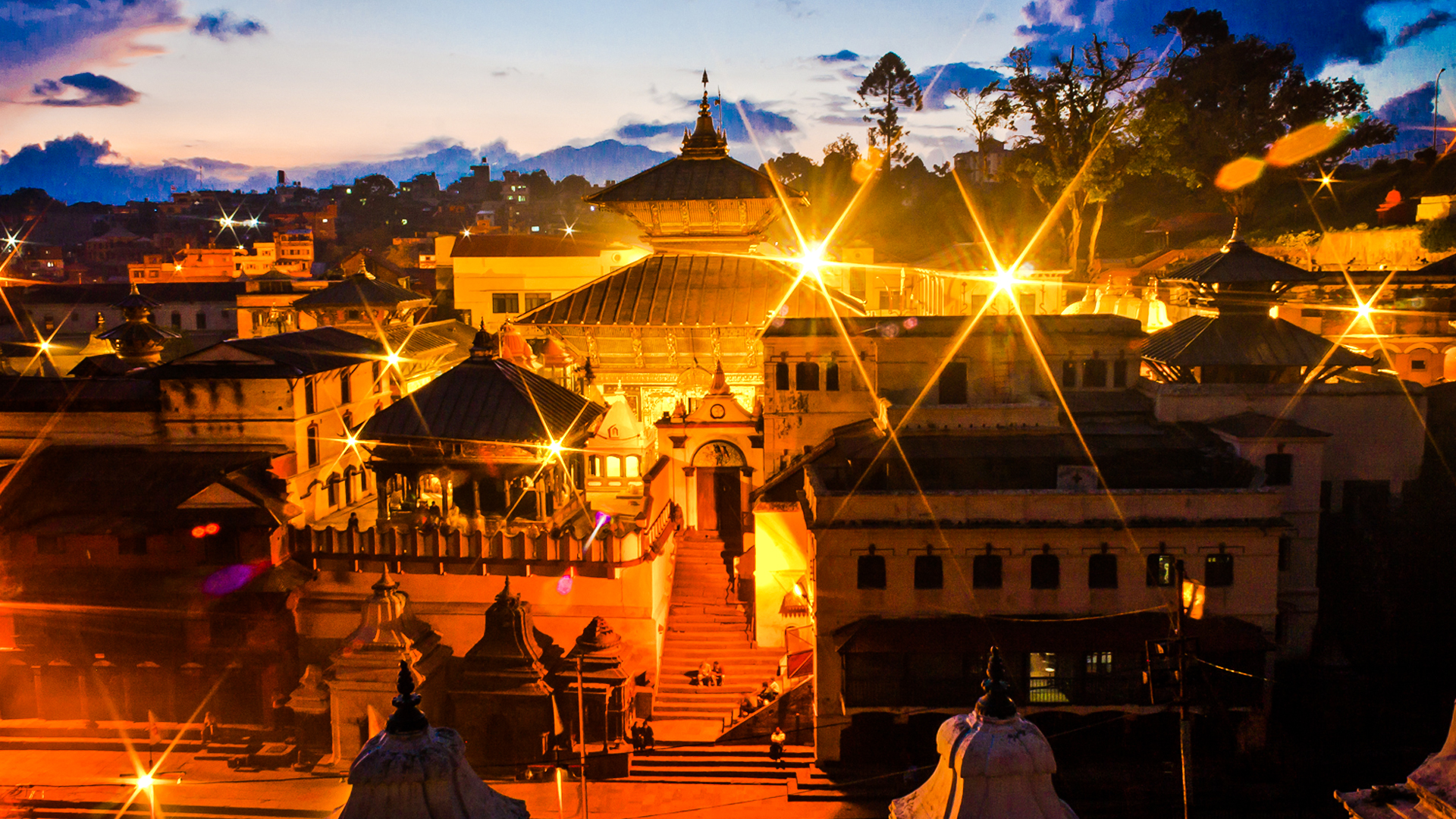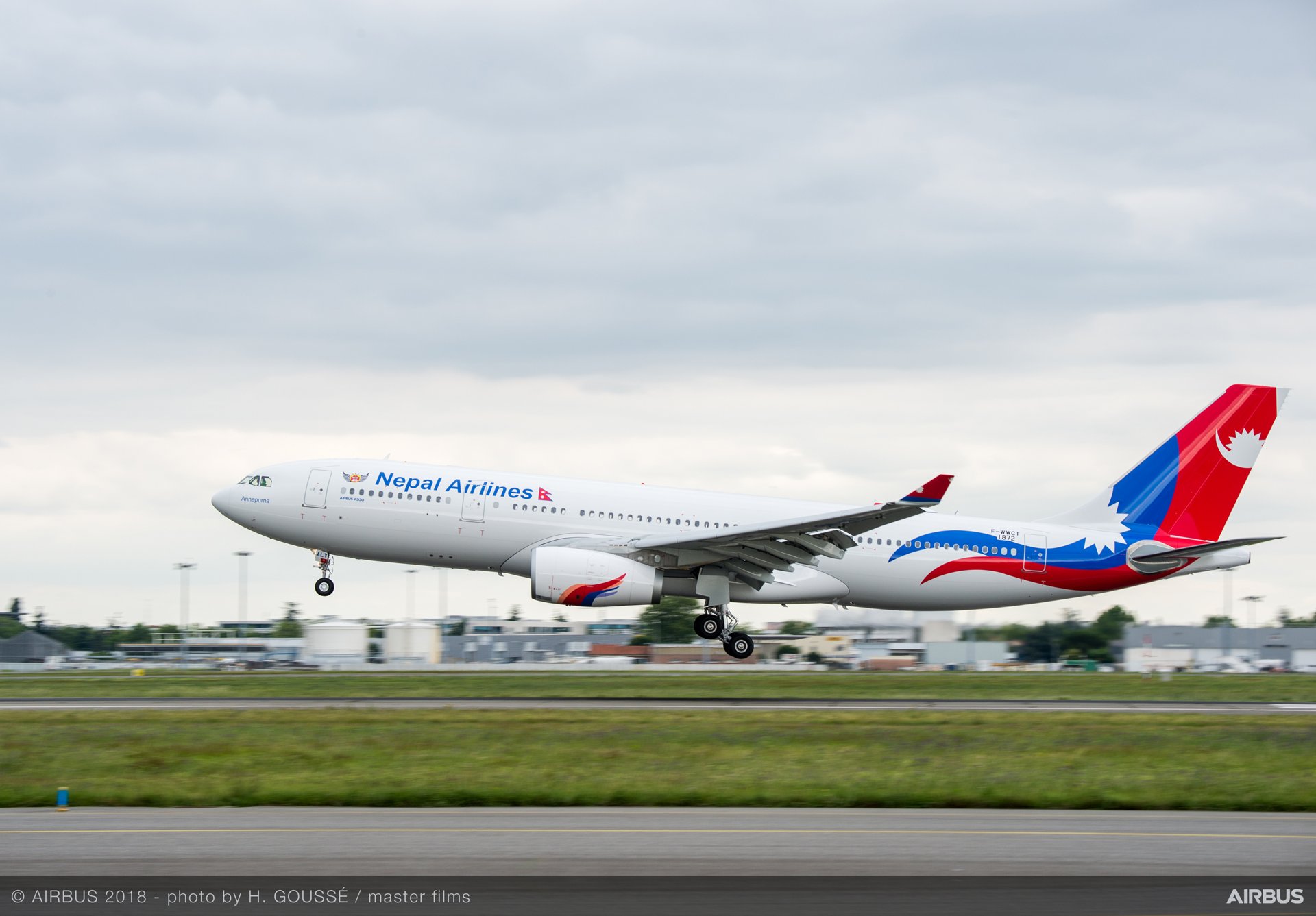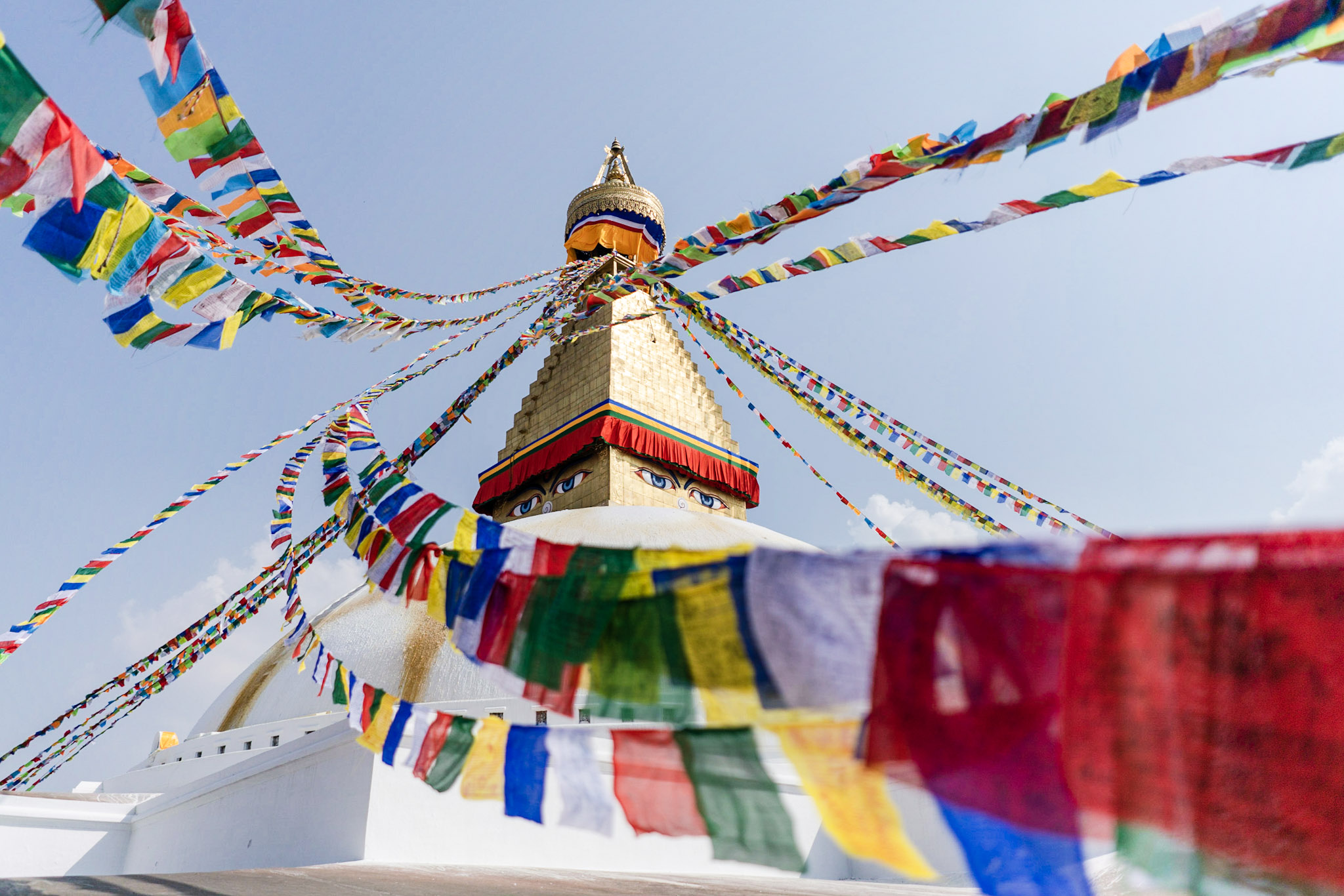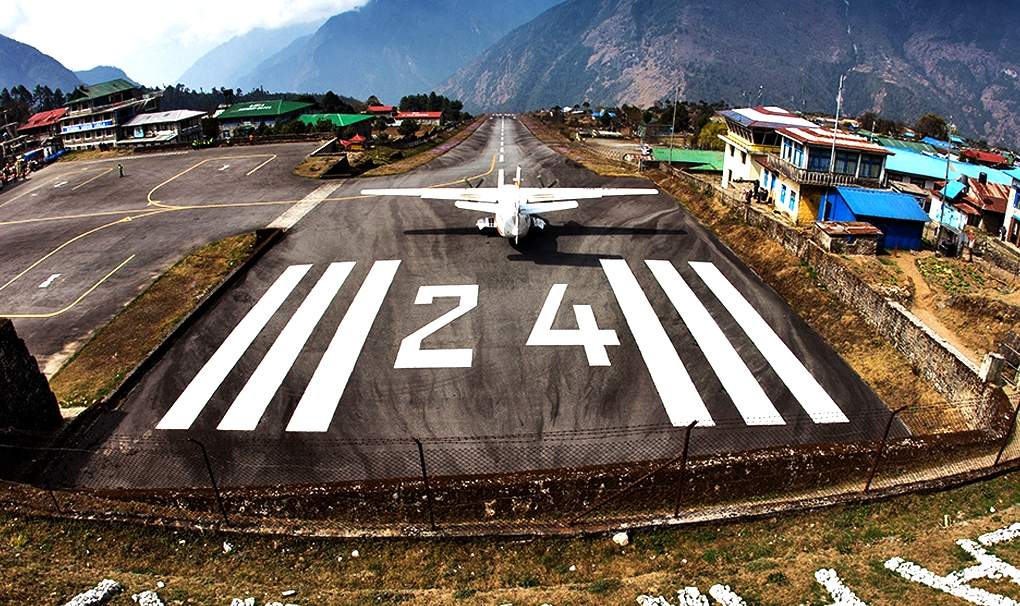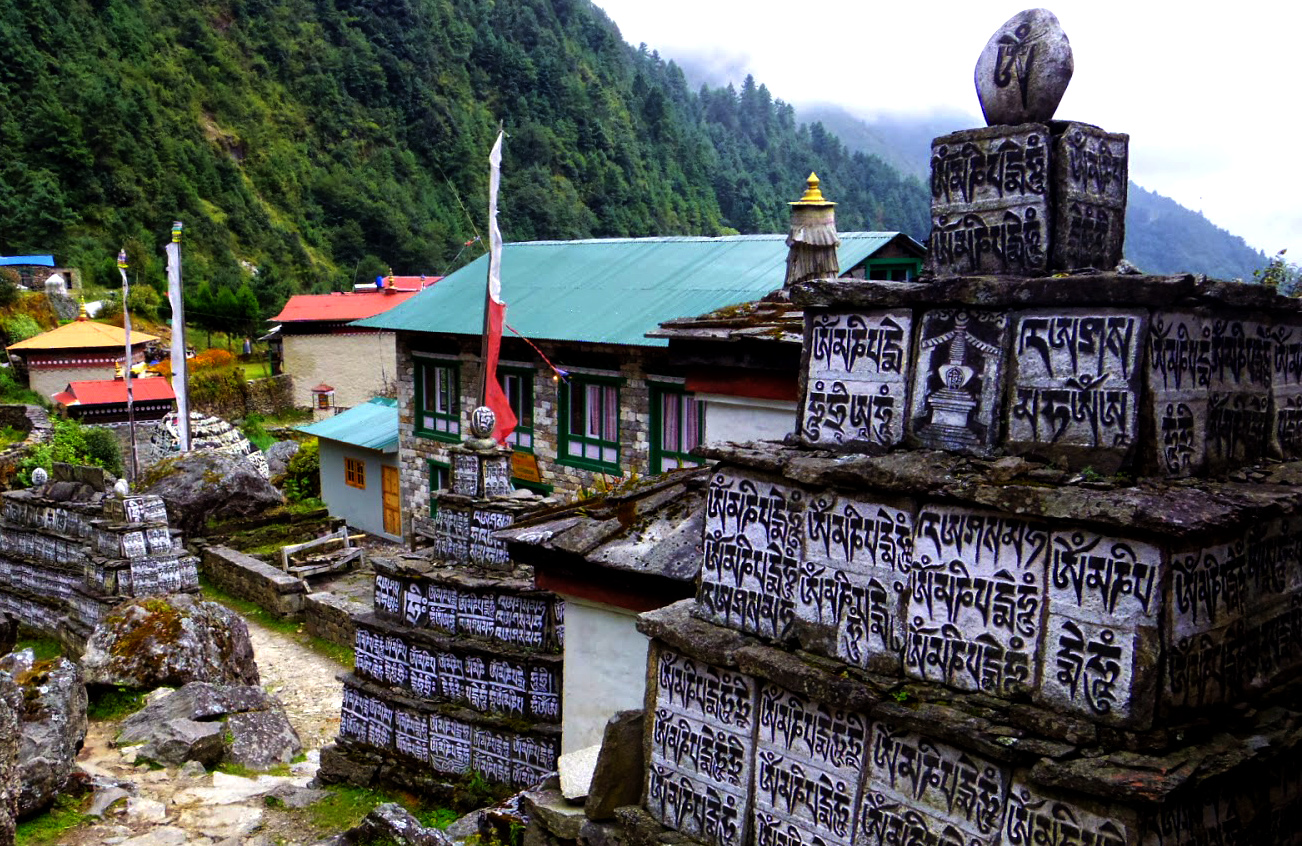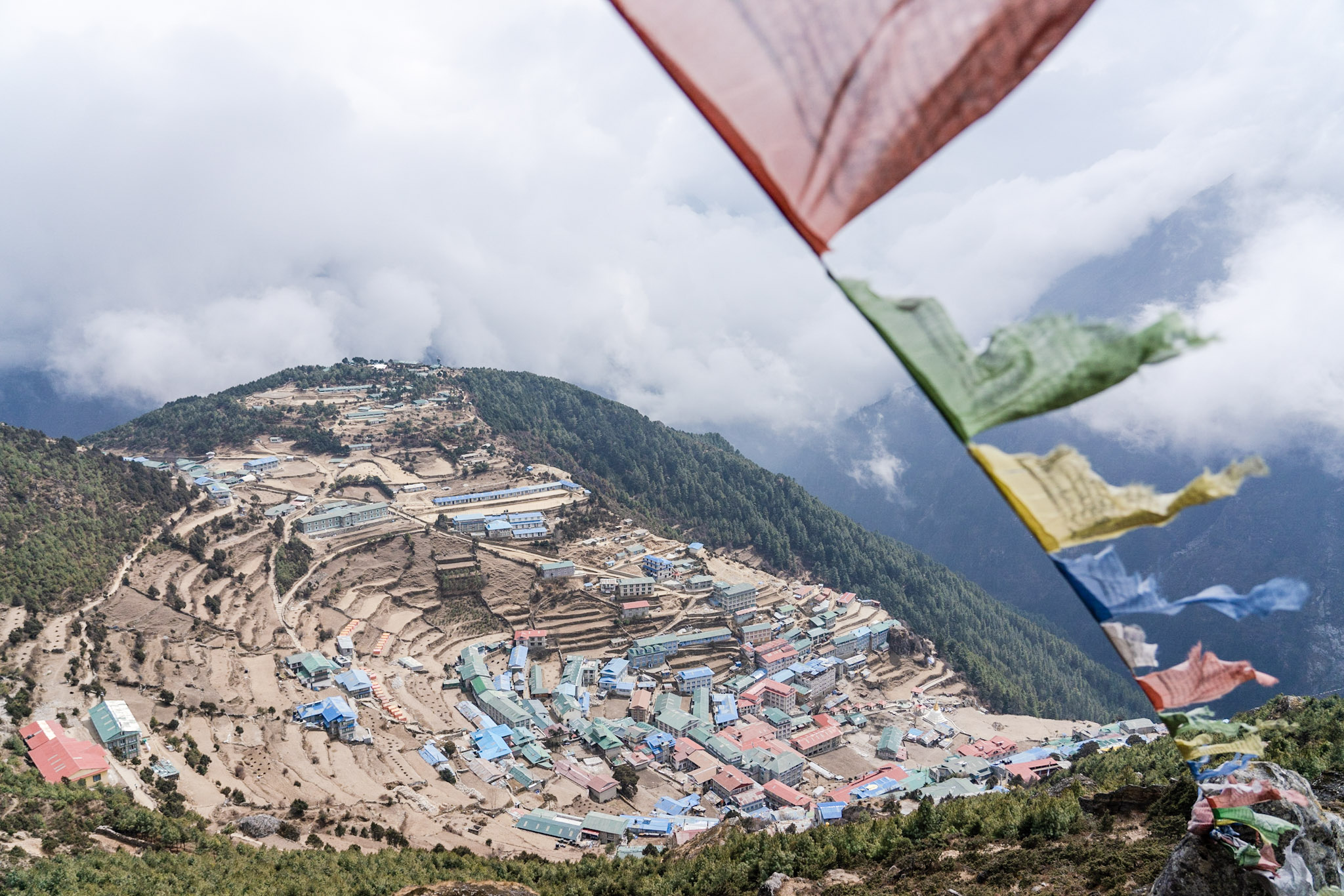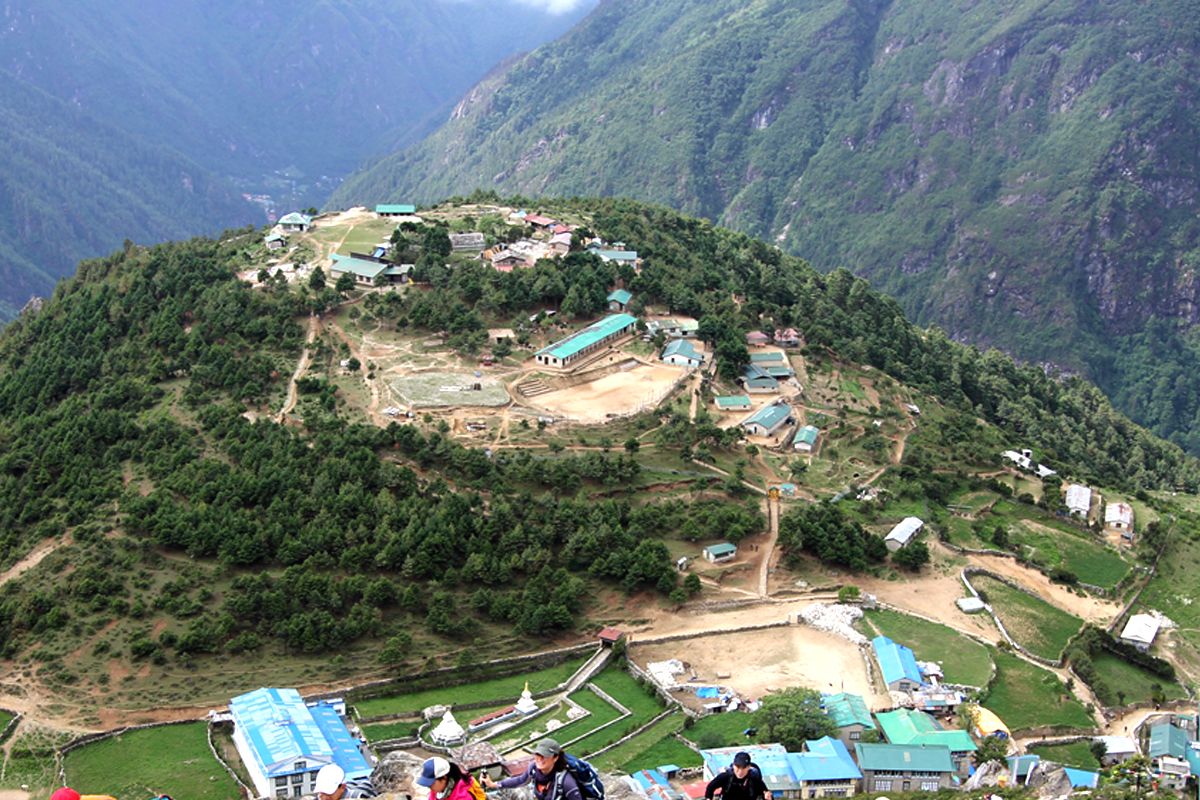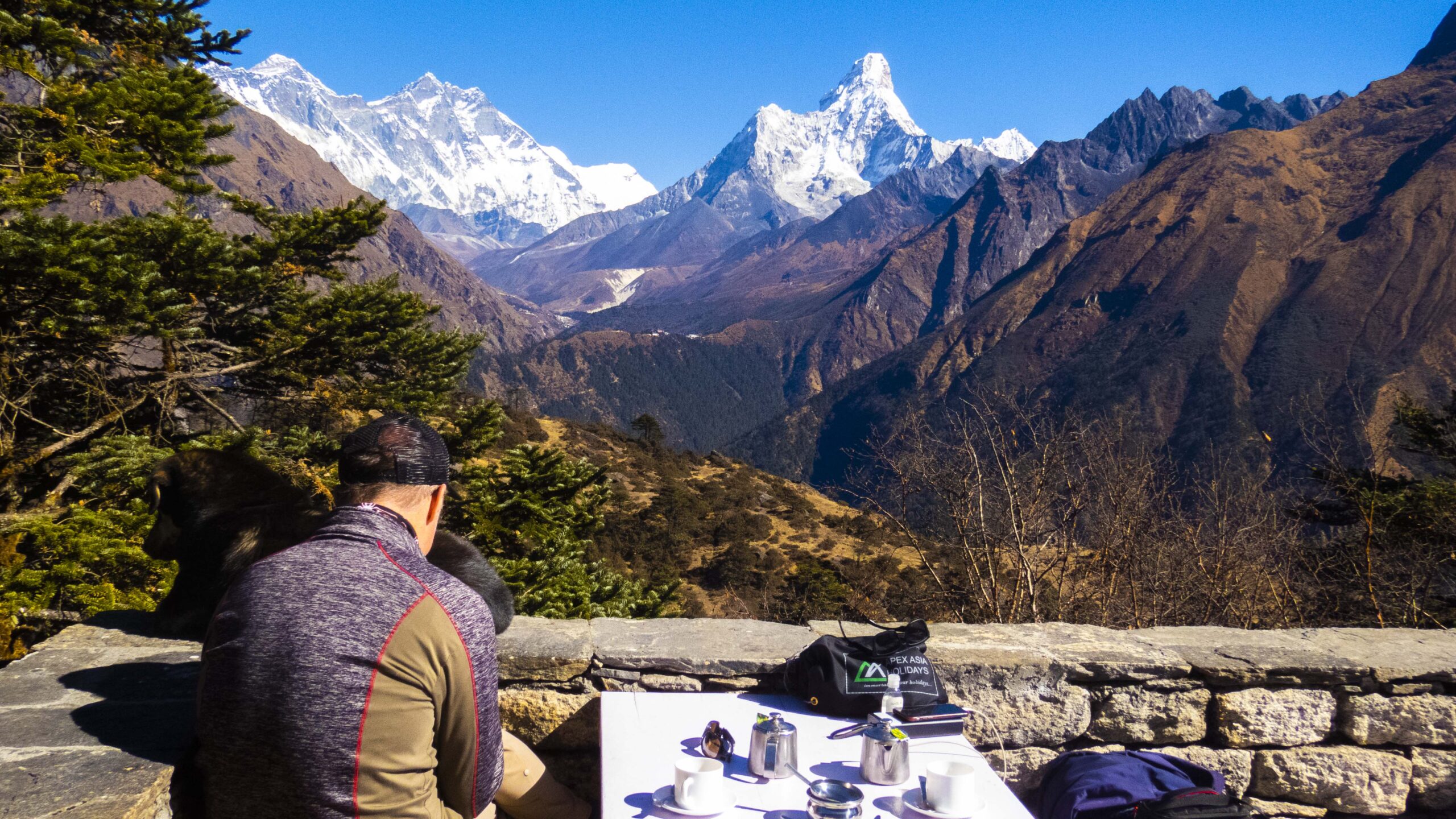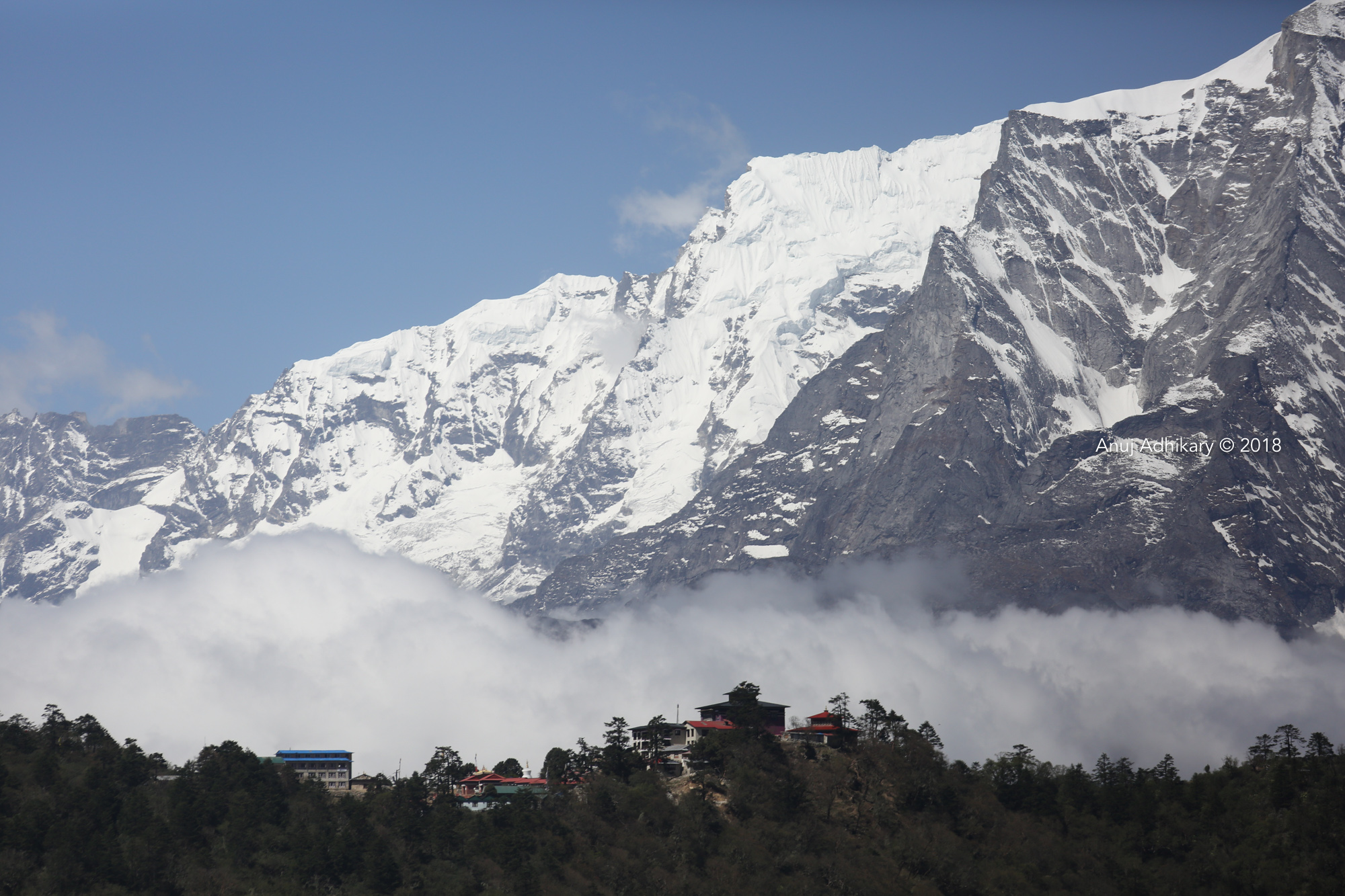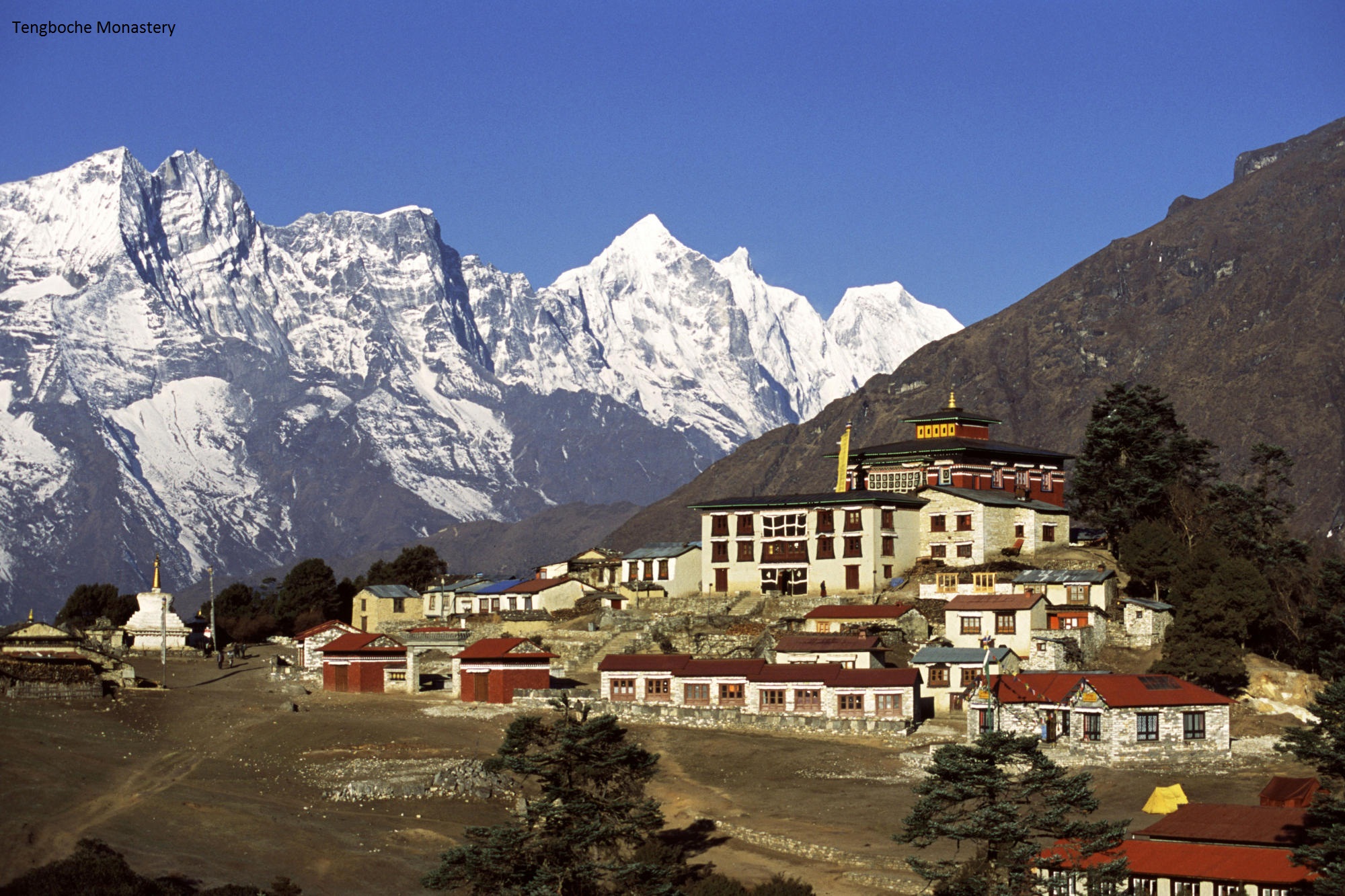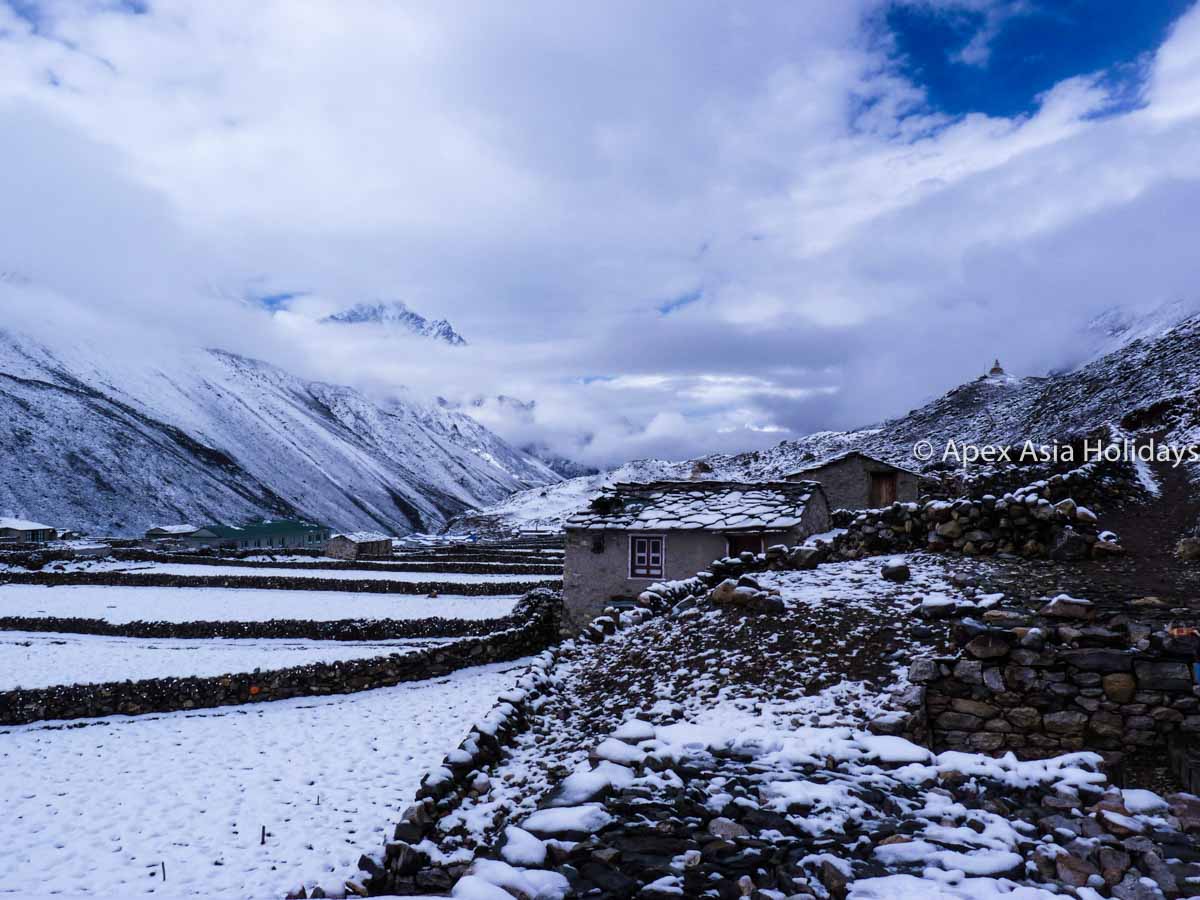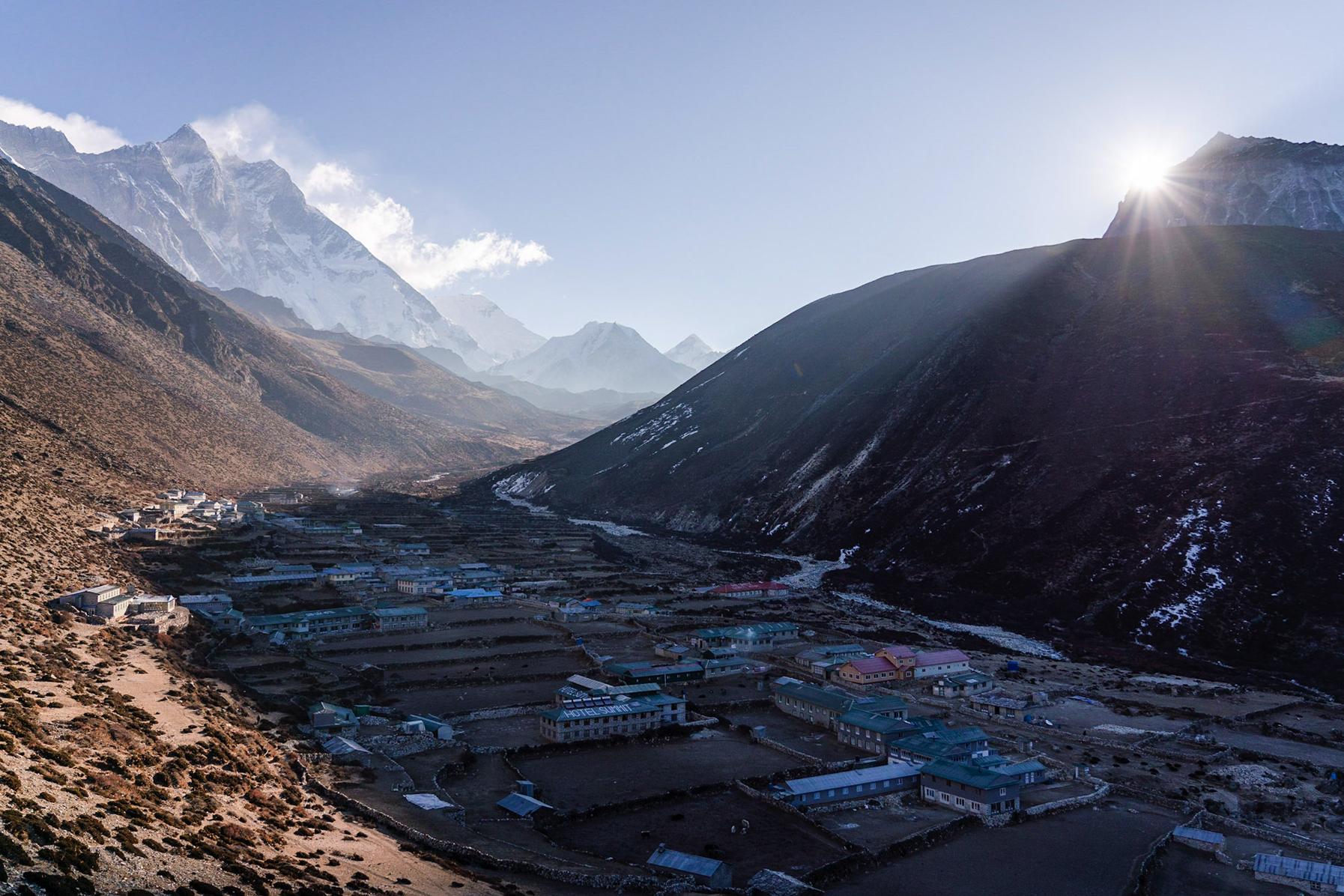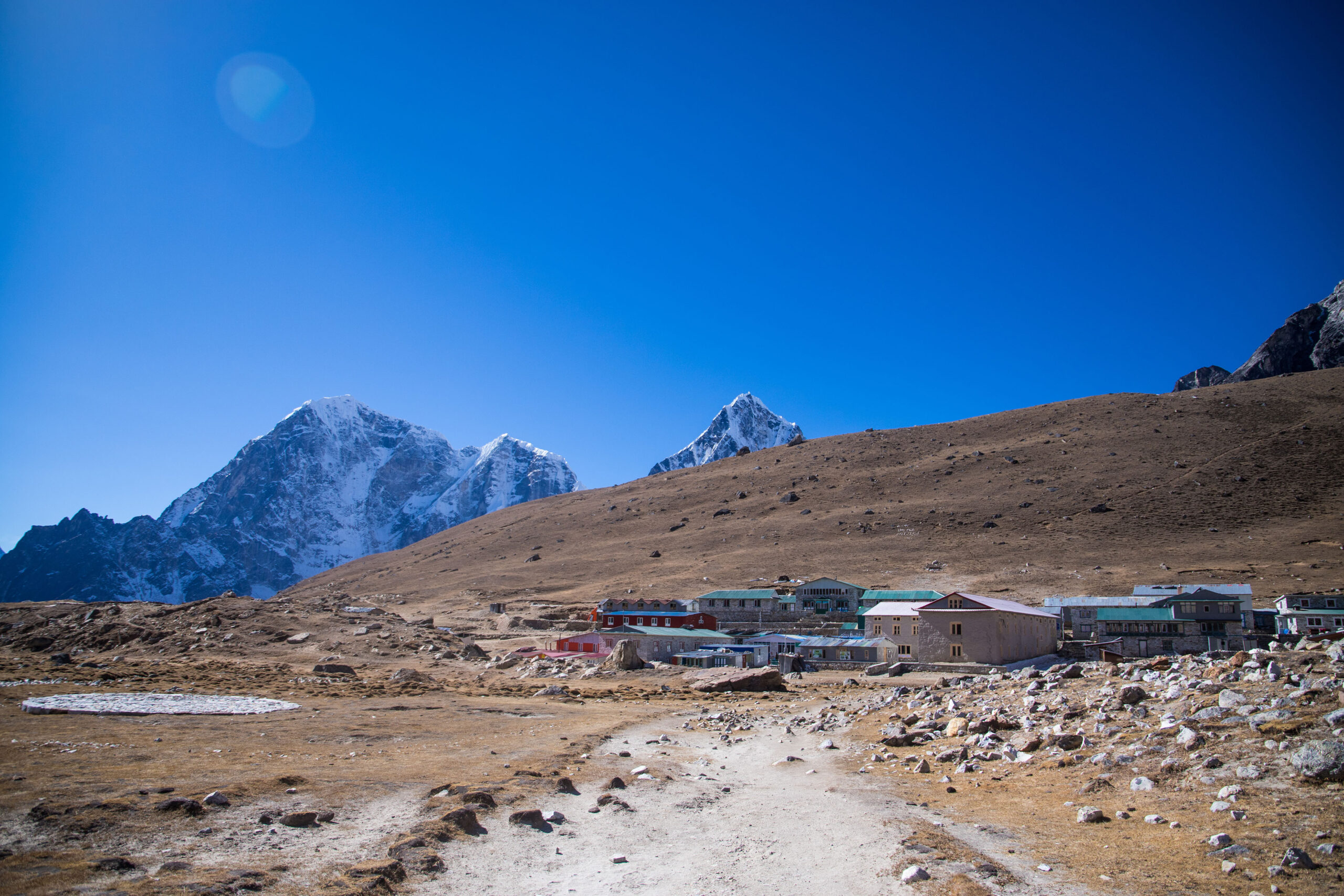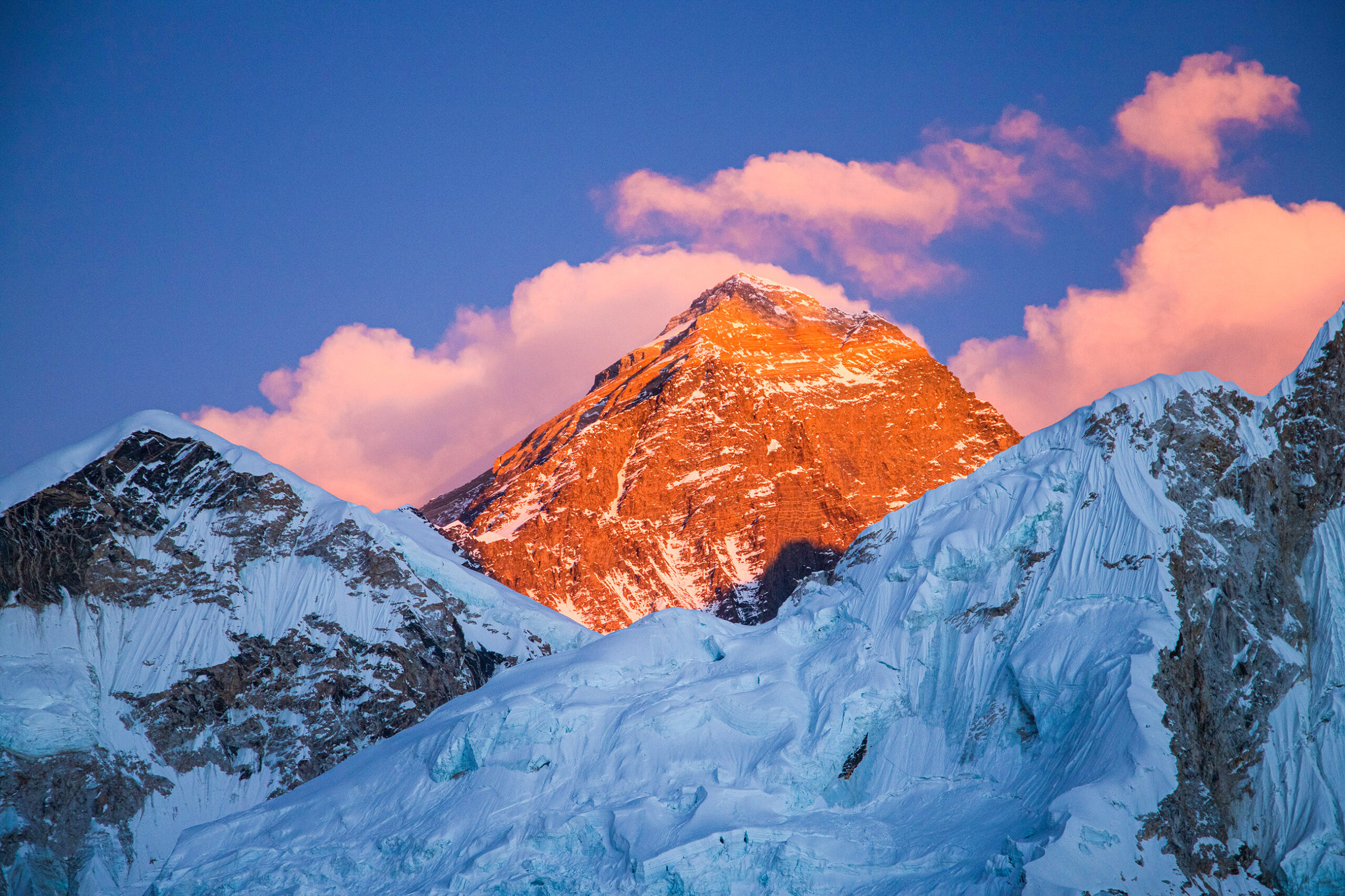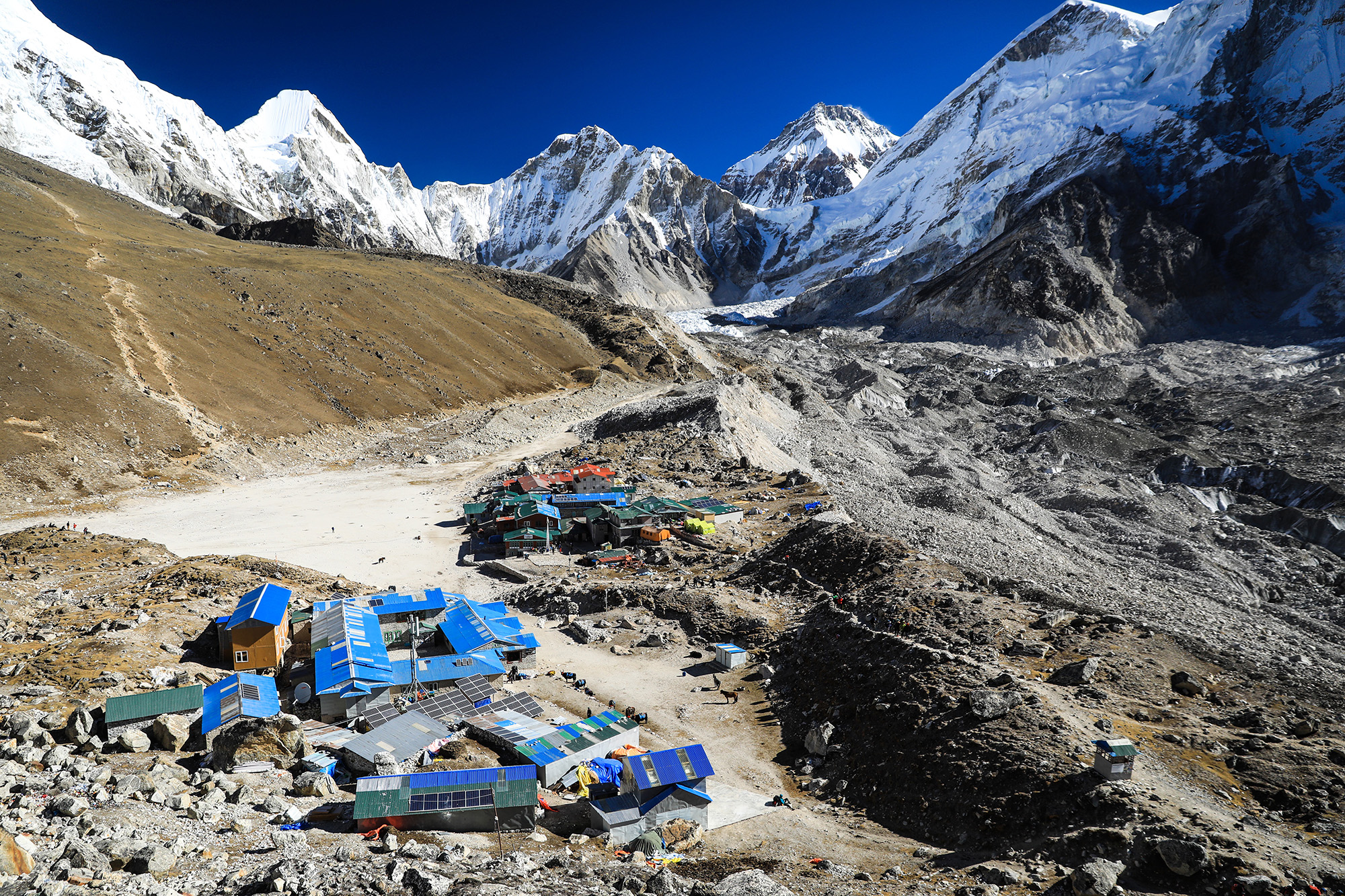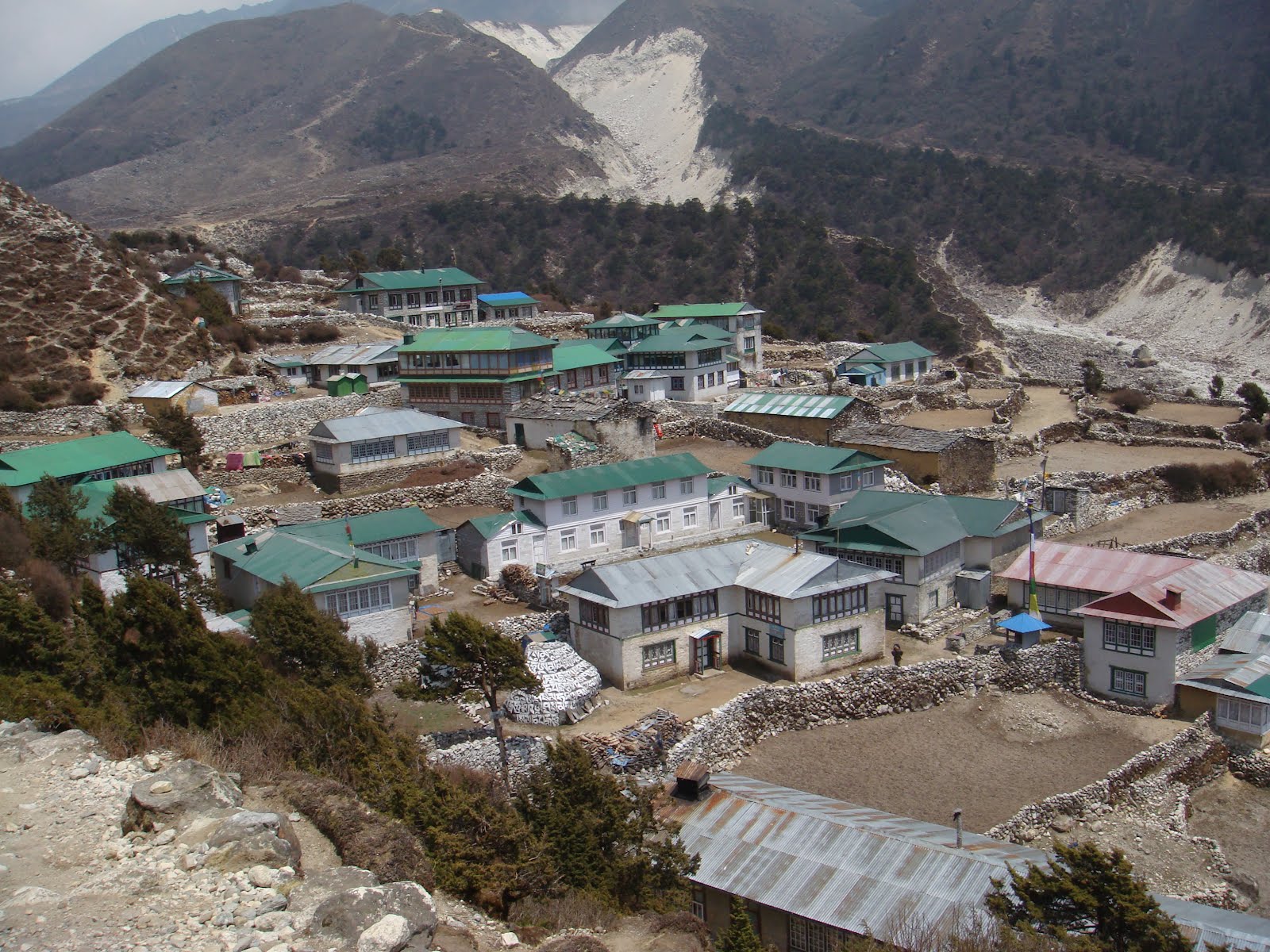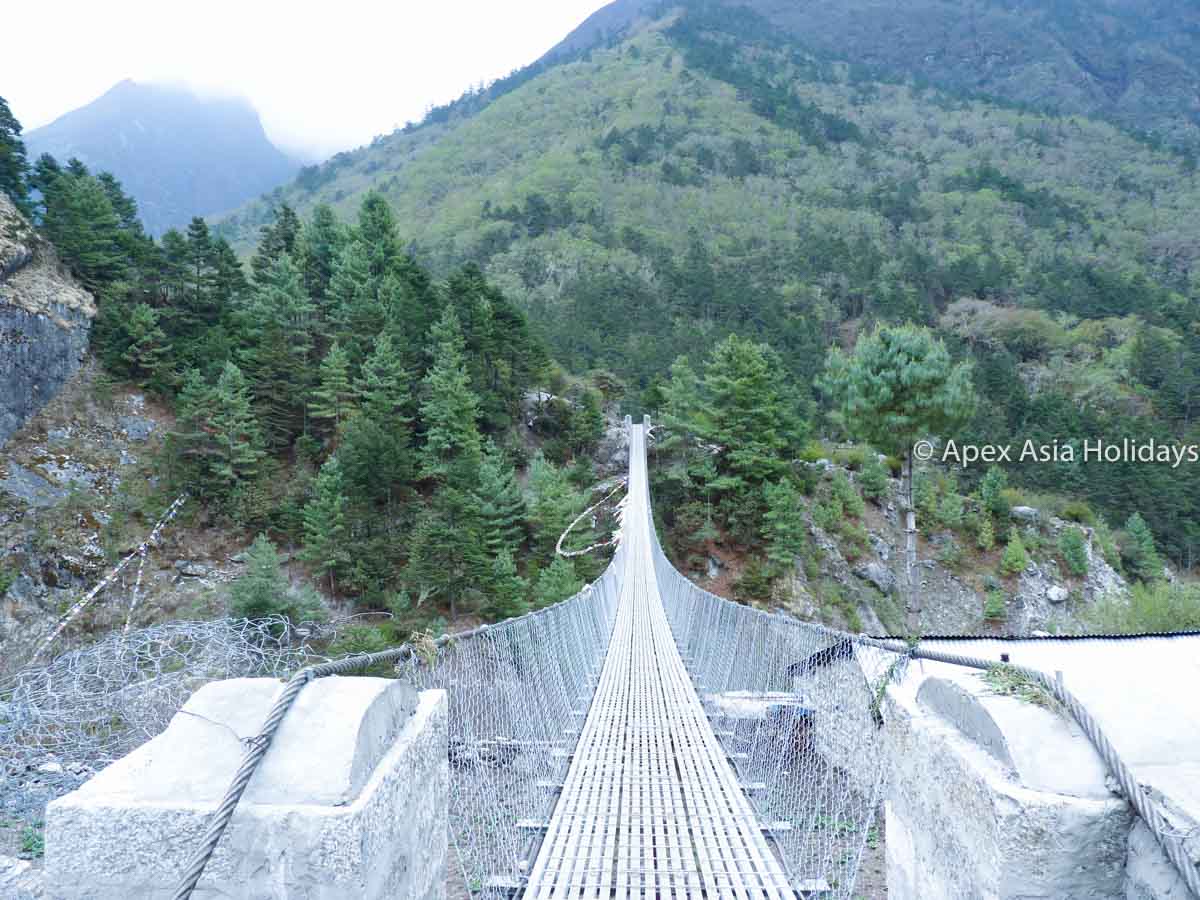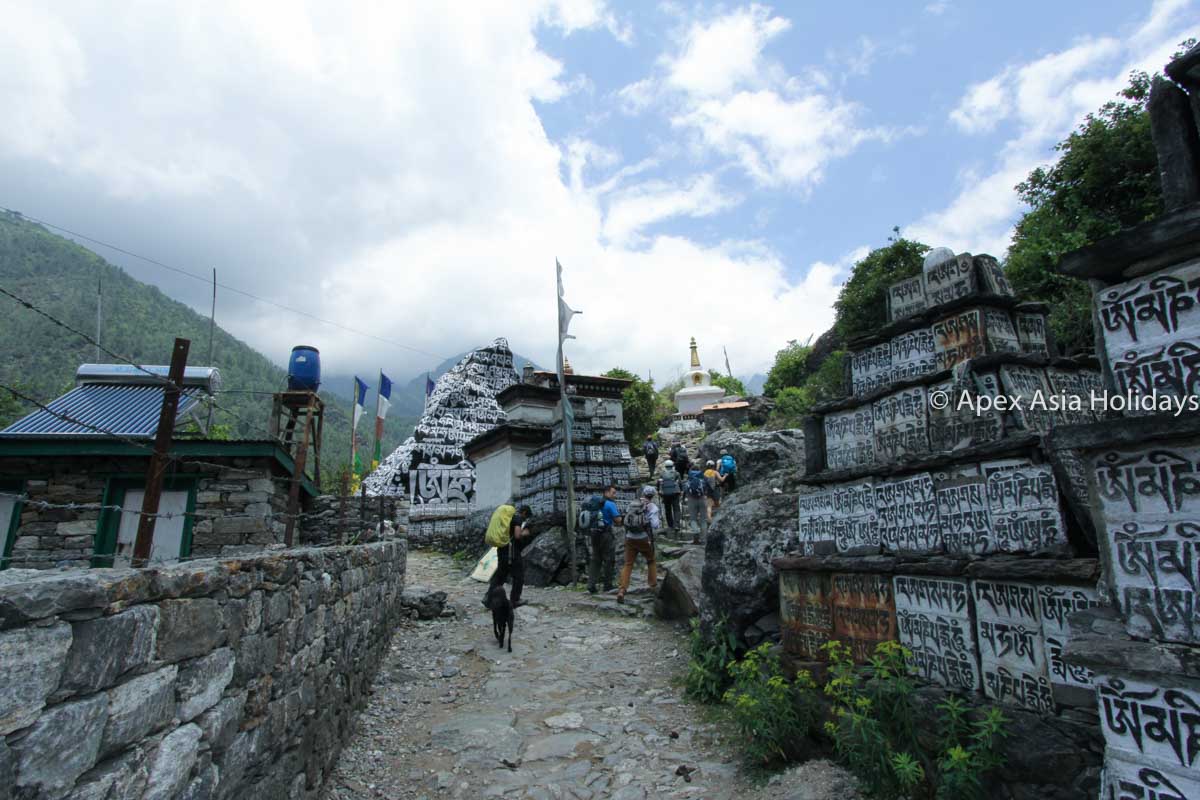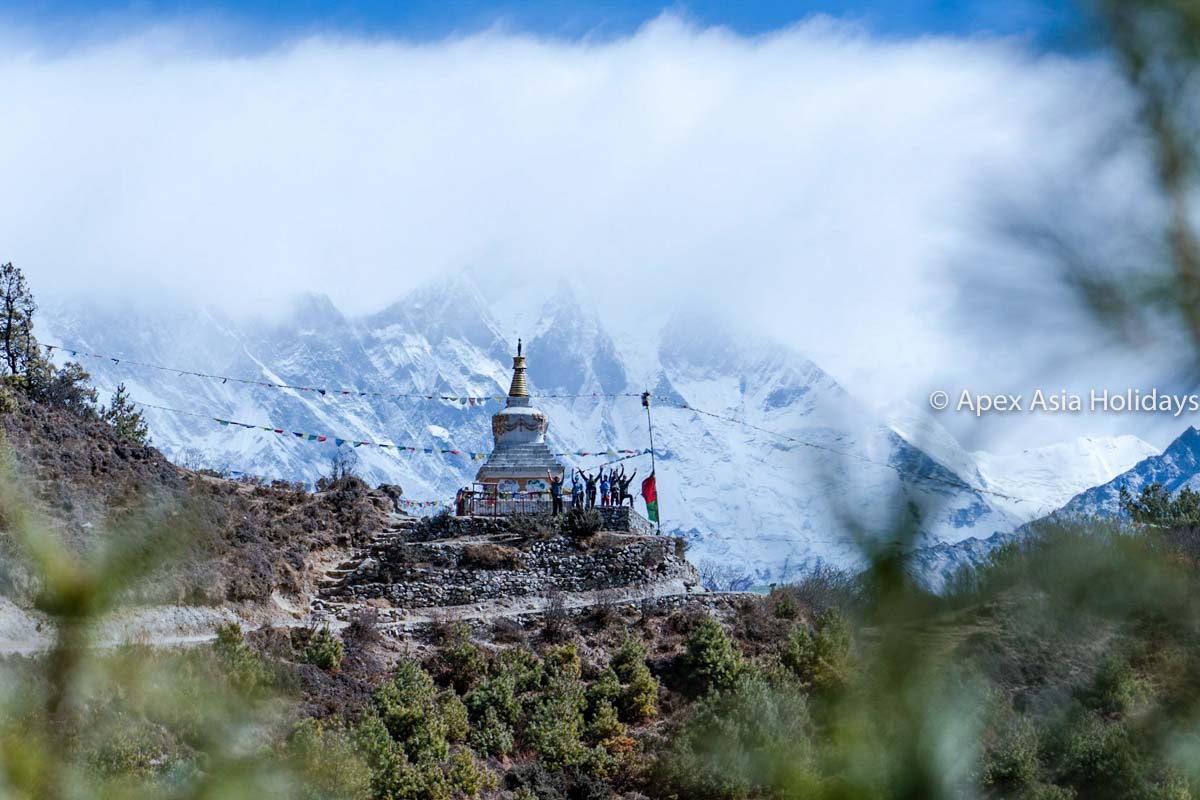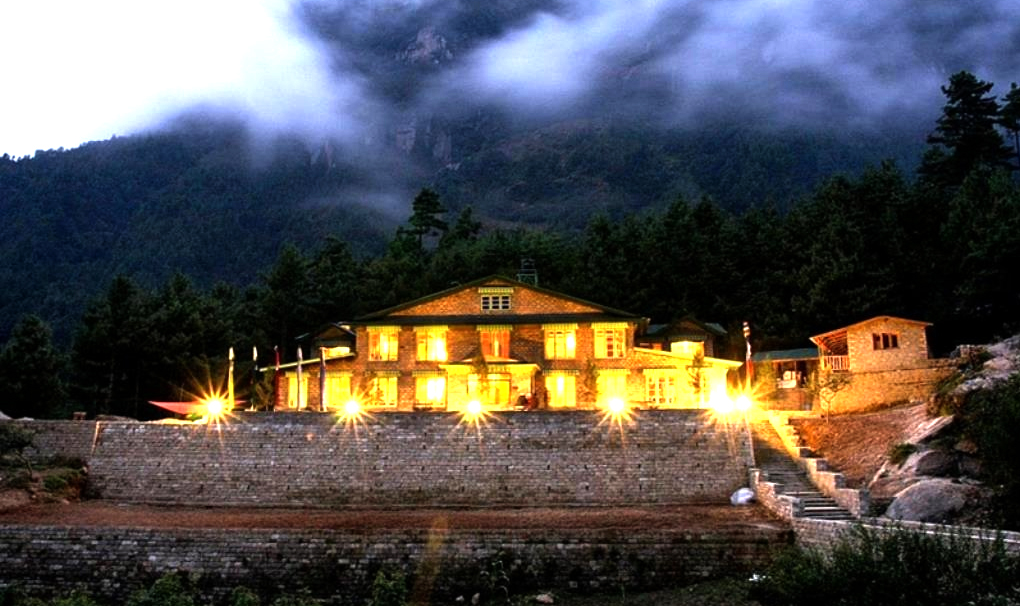Trip Overview
The Lobuche East Trekking Peak is a thrilling adventure in Nepal that attracts climbers from around the world. Standing at 6,119 meters, Lobuche East Treking Peak offers a challenging ascent and multiple routes, primarily drawing adventurers to its southern ridge. This trek combines the demanding nature of high-altitude climbing with the breathtaking vistas of the Himalayas, making it an unforgettable experience for seasoned climbers and enthusiasts alike.
Compared to Island Peak, Lobuche presents a greater level of difficulty, making it an appealing choice for those seeking a more demanding mountain experience. The exhilarating 20-day Lobuche Peak and Everest Base Camp trek begins with a short flight to Lukla. The journey unfolds along the banks of the Dhudhkosi River, featuring a steep climb to Namche, highlighted by crossing the region’s highest suspension bridge over the Dudh Kosi.
Before reaching Namche, a visit to the Top Dada provides the first glimpse of the Everest region, acting as a prelude to the breathtaking views ahead. Exploring Namche includes visits to the Sherpa museum and the Syanboche airstrip, recognized as the world’s highest airport. Enjoying a cup of coffee while marveling at the wild vista of the Khumbu Himalaya, with Mount Everest as its centerpiece, becomes a memorable highlight of the trek.
Continuing the journey involves visiting the Tengboche Monastery, traversing Sherpa villages and valleys, and crossing the memorial pass, which serves as a therapeutic balm for the challenges faced along the way.
To acclimatize to the high altitude, a visit to Kalapathar (5,555m) and Everest Base Camp (5,360m) precedes the Lobuche base camp. The first night in Lobuche is spent at a tented camp elevated at 4,950m above sea level. The panoramic views of Himalayan peaks, including Mt. Everest, Mt. Lhotse, Mt. Nuptse, Mt. Amadablam, Mt. Cholatse, Mt. Thamserku, Mt. Kantega, and Mt. Baruntse, create a visual symphony, making the Lobuche East Peak summit a truly gratifying experience.
The journey to Lobuche East Trek Peak seamlessly blends the challenges of high-altitude trekking with the reward of witnessing some of the world’s most majestic mountain vistas, making it an unforgettable adventure for seasoned climbers and enthusiasts alike.
Tour Highlight
- Expereice of landing and taking off in Lukla airport
- Picturesque view of Mountains and Himalayan Valleys
- Climb up Kalapathar (5,555m).
- Exploring the world highest peak Everest’s Base Camp
- Exchange and Experience culture with Sherpa community
Trip Facts
Trip Itinerary Expand All
Arrival at Tribhuwan International Airport
Pre-trip meeting and sightseeing in Kathmandu (1345m)
Your days activities begin after the breakfast. We arrange a short meeting in your hotel lobby before the city tour. Our representative introduces you with your tour and trekking leader, finalize trek with clearing due amount, sign in a participated form as well as the non-liability disclaimers.
The tour will begin around 8 AM, during the tour you will visit three main highlighted places of Kathmandu, Pashupatinath, Boudhanath Stupa and Bhaktapur Durbar Square.
Pashupatinath Temple is the world most popular Hindu temple, and also the place of cremation lies on the bank of a holy river called Bagmati where Hindu holy people; Sadhu meditating, pilgrims bathing. The process of cremation is burning the dead body with firewood and ghee.
Bouddhanath Stupa is one the biggest Buddhist shrine of the worlds, where you can see the monks are praying in monasteries surrounding the stupa.
And the next spot for the day is Bhaktapur Durbar Square, which is famous with the name of Fifty-Five Windows Durbar; its architect designs mesmerized the peoples. Main attractions of the durbar are The Lion Gate, Golden Gates, The statue of King Bhupatindra Malla and the pottery where the potter makes different kinds of pots.
After back to the hotel, you will have few hours for your last shopping for trek and exploration the Thamel city, one of the busiest touristic town of Kathmandu.
Fly to Lukla (2,840m). Trek to Phakding (2,610m)
Trek to Namche Bazaar (3441m)
The trails goes along the Dudh Koshi rive bank, where you need to cross the majestic river many times. There is a check post before you enter the Sagarmatha National Park, where guide will check in you all for your entire trek. To cross the highest suspension bridge of the Everest Region you need to climb up about half an hour, the bridge laden with prayer flags. The steep climb up to Namche via national park forest gives you a chance to see the national bird (Danhpe) and other endangered animals with Himalayan Thar and more. Finalizing the jungle you will enter Namche, known as Gateway of Everest. Namche is a large town with proper facilities and qualities café, hotels, lodges, Internet cafes and bakeries.
Namche Bazaar (3,441m)acclimatization day
Today is a rest day to acclimatize to high altitude. The highlight of the day is the hike up to the Syangboche airport, the highest airport of the world and Khumjung Village. You will go on the short trek from hotel to visit the museum celebrating the traditional customs of Sherpa people. From the top of the hill, you see the stunning sunrise and sunset views over the Khumbu Valley.
Trek to Tengboche (3880m) Visit Monastery
Today you will go to one of the oldest monasteries in Khumbu Region, called Tengboche monastery, which is the largest monastery of Everest Region. About five hours walking you will get to Tengboche, the trail is undulating. The monastery lies at an altitude of 3880m. Ornate wall hangings, a twenty-foot long sculpture of Buddha, musical instruments and robes of the Lamas are the main attraction of the monastery. From the monastery, you can see the beautiful snowcapped mountain including Thamserku and Ama Dablam.
Trek to Dingboche (4350m)
Today the trek will descend from Tengboche to Debuche and cross the Imja Khola suspension bridge and climb up to the Pangboche. The uphill treks continue for almost 6 hours to get to Dingboche, which is a charming Sherpa village that lies at the altitude of 4350m. Entering the Dingboche village, you will see views of Lhotse, Island Peak, and Ama Dablam.
Day Hike to Nangkartshang Peak (5090m)
Trek to Lobuche (4,910m)
You will leave Dingboche after breakfast by catching the trail of Lobuche. The trail continues for five hours via the lateral moraine of the Khumbu Glacier and passes by stone memorials of the climbers who perished while climbing. From Thukla you will see the paradise view of the Himalayas and Pheriche valley.
Trek to Everest base camp (5365m) & return to Gorakshep(5,180m)
Today the trail goes up to Everest Base Camp (5,365m) from Lobuche, via Gorakhshep. From the base camp and while heading to base camp, you’ll see views of giant mountains including Mt. Everest, Nuptse, Pumori and much more. Afterward exploring the Everest Base Camp back to Gorakshep for the overnight stay. It will be about 8hrs in total for the walk.
Trek to Kalapathar (5,555m) & return to Lobuche (4,910m)
Today you will climb up the second highest point Kalapathar (5555m) of the trek with comparing the summit of Lobuche Peak. The viewpoint Kalapathar offers striking views of mountains of Khumbu Himalayan Range. After spending half an hour in the top, come back down to Gorkashep and descend to Lobuche.
Trek to Lobouche Base Camp (4,950m)
This is another target of the trek: Everest Base Camp and Lobuche East. The first half of the expedition is over flat terrain, but the second half of the path begins ascending to the Lobuche base camp (4950m). Today and next two days you have to spend in tented accommodation and meal prepare by professional camping cook.
Trek from summit to Lobuche East Peak (6,119m) & return to Base Camp (4,950m)
Today is your main adventure day; weather permitting, early in the morning you‘ll begin the climb up Lobuche peak (6119m). The hike takes about ten hours. At the summit you’ll behold panoramic views of Everest, Lhotse, Nuptse, Ama Dablam, Tawache, Cholatse, Pumori, Changri, and more. After a trip to the top, you safely make your way down then same day, returning to the Base Camp.
Spare day in case of bad weather
Spare day in case of bad weather
Trek to Pangboche (3,995m)
Trek to Namche Bazaar (3,441m)
Follow descending trails and then an uphill to reach Namche. You first trek down to Debuche, hike up through the rhododendron forest to reach Tengboche. Take a short rest and resume down to cross Dudh Koshi River. We have lunch at Phunki Tenga. After lunch again follow the trail of Namche, until you get Sanasha. The trail climbs gradually up to Namche from here. Enjoy the evening at Namche.
Morning flight back to Kathmandu
This morning you will flight out from Lukla to Kathmandu, and upon arrival your guide transfers you to the hotel. A good rest after a long trek will be crucial. In the evening, you have leisure time to stroll around Thamel and do any souvenir shopping if you like.
Morning flight back to Kathmandu
This morning you will flight out from Lukla to Kathmandu, and upon arrival your guide transfers you to the hotel. A good rest after a long trek will be crucial. In the evening, you have leisure time to stroll around Thamel and do any souvenir shopping if you like.
Leisure day and farewell dinner in Kathmandu
Today is a leisure day, and you have the option of doing extra activities if you feel it. You can get more information in our Activities Page. And in the evening you will be served a farewell dinner in typical Nepali Restaurant with Nepali folk music and dance. It is also the time of reviewing the trip with your guide.
Transfer to the airport for your final flight departure
The trip concludes today. Your guide will drop you off at the international airport for your departure back home.
Itinerary Informations
Lukla Flights:
All we know is that the Lukla flight is sensitive in the case of weather. Instantly it may be delayed and canceled as well. A tiny Himalayan airport has difficulty facing heavy traffic which is why sometimes the flight may be delayed. So, we suggest, if you are trekking in Everest, please make sure at least you have two days additional in the program.
In the case of a weather cancellation, the best alternative to get Lukla is to charter a helicopter because the copter can fly in a lower visibility of 1,500 meters. However, Twin Otter and Dornier aircraft need minimum visibility of 5,000 meters. What about the Helicopter cost? Is it getting instant or need to be in the queue? A helicopter charges US $ 2500 per flight to Lukla from Kathmandu. And the US $ 500 per person on a sharing basis. Except for the emergency, during the high season and extreme weather of Lukla, you may not get a helicopter instantly or need to be in the queue. Also, if you have requested the Helicopter for less than 24 hours, you may need to wait because of the limited number of helicopters, and they’re using various activities in the mountains.
Lukla flight from Manthli Airport, Ramechhap
Due to the air traffic in Kathmandu during the peak months (March, April, May, September, October, and November), CAAN has promulgated the notice that the flight has been shifted to Manthali from Kathmandu to Lukla. If there are changes will update you ASAP.
Standard Itinerary and Private Trip
It is the notice about Standard Itinerary and Private Trip. The provided itinerary is standard, and if you want to customize it, you can do it. OR you can go through our Plan Your Holidays page.
Travel Insurance and Covers
We strongly recommend you have travel insurance that covers adventure activities such as trekking/hiking above 15,000 feet. And must include flights delayed/canceled by bad weather, accidents, evacuations, etc.
Keep in Mind
Sometimes, unusual weather changes, natural disasters, flight delays, and cancellations, government rules, local political situations, health conditions of trekkers may change your itinerary. At that point, our leading guide will decide and try to minimize the impacts and run the trip smoothly, but we are not liable for any additional costs if needed.
Always options for Upgrade
Please you can upgrade your accommodation and transportation service to regular. We can provide you with 5-star hotel accommodation and the best available private car/ jeep services. And also domestic flights including the Helicopter Charter.
What Includes & Excludes
Includes
Accommodation
- Three Nights in Hotel Kathmandu in BB Plan
- One or Two nights in tented camp for peak climbing.
Flight
- Kathmandu-Lukla-Kathmandu domestic airfare
Meals
- Three meals (Breakfast, Lunch, and Dinner) during the trek.
- Breakfast is In Kathmandu Hotel
Guides and Porters
- An English speaking local guide
- Trekking Porters - We Assign a porter for each two trekkers.
- An English speaking local climbing guide
Transports
- All ground transportation as per itinerary
- Kathmandu - Ramechhap round trip in sharing vehicle
Additional Services
- All government taxes and official expenses.
- Farewell dinner one night before the client’s final departure in a typical Nepali Restaurant with culture dance. Your guide will accompany you.
- Trekking/tour permits, entrance fees.
- Accommodation, foods, insurance, salary, equipment, and medicine for field staffs.
Excludes
- Anything not mentioned in the price includes.
- Personal trekking gears/equipment.
- Tips for trekking staff (Tipping is expected).
- Lunch and dinner in the city.
- All drinks including bottled/boiled water along the trekking route
- Visa fees and travel insurance.
- International airfare to and from Nepal.
Join the Departure
Guest Reviews
We highly recommend Broad Adventures they provided exceptional guidance on our Everest Base Camp trek. Our guide’s Gynau’s professionalism,...
Read More...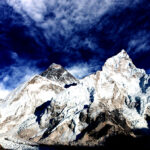
David Neufeld
CanadaIf you are looking for a tour to see the Mt Everest base camp look no further. I have...
Read More...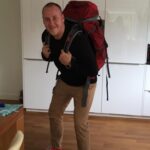
Tim Troost
AustraliaI was looking at an exotic trek adventure. After looking for a bunch of places to go I thought...
Read More...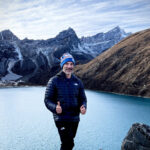
Keith B.
USAKeshab was our most gracious and amiable guide in Kathmandu and to Everest basecamp. My wife accompanied me on...
Read More...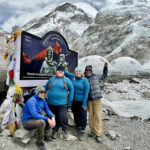
Ken Byers , Nevada
USAMy son and I went for trekking in Nepal in 2009, and we were lucky to have Keshab Khanal...
Read More...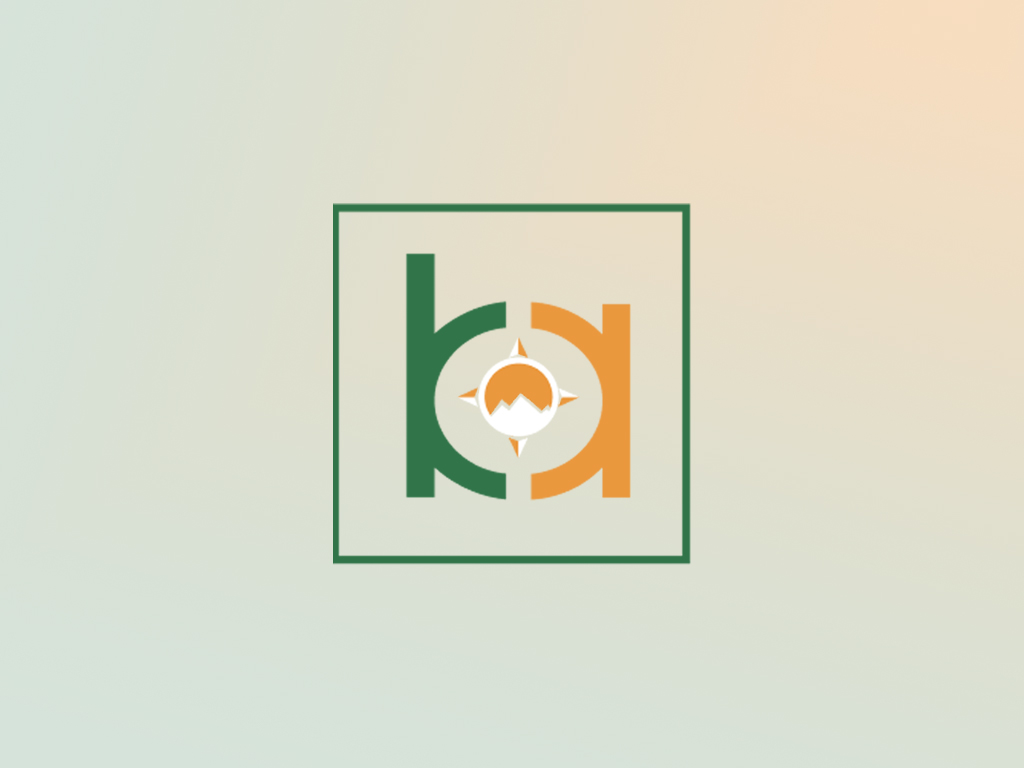
Dr. Raphael Hemmendinger
Jerusalem , IsraelIn 2005 I came to Nepal for the second time, this time whith a very specific queste. I wanted...
Read More...
Richard Rijken
Amsterdam , NetherlandsI was always willing to go to the Himalayas and explore some of the beauties hidden in the sacred...
Read More...
John Peter
Manchester , United KingdomNamaste! This was my first time to Nepal, and I had an amazing time on my trek. From the...
Read More...
David Patrician
Hamburg , GermanyI was on trekking from 24.10.10 to 5.11.10 in the half part of Annapurna circuit from Bhulbhule to Jomsom....
Read More...
Vaya Bairaba
Athens , GreeceImportant Info
Comprehensive Guide to Everest Base Camp Trek and Lobuche East Peak Climb
Embarking on the Everest Base Camp trek, combined with the climb of Lobuche East Peak, is an exciting and adventurous journey. To make the most of your experience, it’s essential to have key information at your fingertips. This comprehensive guide provides valuable insights to help you plan and prepare for this trek.
Everest Base Camp Trek Overview
How High is Everest Base Camp?
Elevation: 5,364 meters (17,598 feet)
Highest Point on Trek: Kalapatthar at 5,555 meters (18,225 feet) for unobstructed views of Mount Everest and the surrounding peaks.
Accommodation During Everest Base Camp Trek
Luxury Trek Package:
Upgraded accommodations and enhanced facilities in Kathmandu and throughout the trek.
Teahouses/Guesthouses: Basic lodging with improved facilities in places like Lukla, Phakding, and Namche, offering rooms with attached toilets/bathrooms.
Permits Required:
Trekking Information Management System (TIMS) Permit:
SAARC Nationals: NPR 600 per person
Foreign Nationals: NPR 2,000 per person
Sagarmatha National Park Permit:
SAARC Nationals: NPR 1,500 per person
Foreign Nationals: NPR 3,000 per person
Khumbu Pasang Lhamu Rural Municipality Entrance Card:
NPR 2,000 per person for both SAARC and foreign nationals
Safety and Preparation:
General Safety: The trek is generally safe for individuals in good health. Altitude sickness is a significant challenge.
Guide and Porter Support: Certified guides and porters equipped with oximeters and first aid training.
Altitude Sickness Prevention: Consult a medical expert, avoid alcohol and tobacco, maintain hydration, and eat a carb-rich diet. Gradual acclimatization is essential.
Best Time for Everest Base Camp Trek:
Spring (March-June): Mild temperatures, blooming flowers, and clear skies.
Monsoon (July-mid-September): Heavy rains, quieter trails.
Autumn (end of September-November): Pleasant weather and clear views.
Winter (December-February): Cold temperatures, solitude, and snowy trails.
Flying into Lukla:
Lukla Airport (Tenzing Hillary Airport): Located at 2,840 meters, entry point for Everest treks.
Flight Options:
- Ramechhap/Manthali Airport: 5-6 hour drive from Kathmandu, followed by a 20-minute flight.
- Kathmandu Airport: 35-minute flight, operational during off-peak months.
- Baggage Allowances: Maximum weight: 15 kg (33 pounds) including duffel bag and daypack. Extra fee for excess weight (USD 2-5 per kilogram).
Travel Insurance:
Mandatory Coverage: High-altitude adventure activities, flight disruptions, accidents, and emergency evacuations.
Recommended Providers: Tugo, United Health Care, World Nomad, Blue Cross, Fast Cover, Allianz Australia, Ergo, Europe Assistance, Austrian Alpine Club, Allianz Europe, ICICI Lombard.
Additional Tips for a Successful EBC Lobuche East Trek:
Tipping: Customary for guides, porters, and local staff (15% of the total trek cost).
Charging Devices: Renewable energy sources used, fee for charging (USD 1-5 per charge).
Food Options: ‘Dal Bhat’ (rice and lentils) and other international dishes.
Training Program: Cardiovascular exercises, strength training, and hiking. Start two months in advance.
Trekking Distance: Approximately 130 kilometers (80 miles) round trip.
Lobuche East Peak Climbing Overview
Elevation:6,119 meters (20,075 feet)
Climbing Route and Difficulty:
Route:
Follow the standard Everest Base Camp trek itinerary.
Trek from Lobuche to Lobuche High Camp (5,400 meters / 17,716 feet).
Summit attempt of Lobuche East Peak and return to Lobuche.
Trek back to Lukla.
Difficulty:
Technical challenges requiring mountaineering skills (crampons, ice axes, fixed ropes).
High levels of physical fitness and acclimatization essential.
Climbing Equipment:
- Personal Gear: Thermal layers, waterproof and windproof outer layers, down jacket, trekking pants, insulated gloves, mountaineering boots, gaiters, warm socks, headgear, and sunglasses.
- Technical Gear: Crampons, ice axe, helmet, harness, carabiners, ascender/descender devices, ropes, anchors, trekking poles, headlamp, and a backpack.
Permits Required:
Lobuche East Peak Climbing Permit:
- Spring (March-May): USD 250 per person.
Autumn (September-November): USD 125 per person.
Winter and Summer (December-February, June-August): USD 70 per person. - Sagarmatha National Park Permit.
Khumbu Pasang Lhamu Rural Municipality Entrance Card.
Safety and Preparation:
Altitude Sickness Prevention: Gradual acclimatization, hydration, carb-rich diet, and altitude sickness medications.
Climbing Safety: Certified guides, proper gear, weather checks, and a comprehensive first aid kit.
Training: Cardiovascular exercises, strength training, practice with climbing gear, and mental preparation.
Best Time for Lobuche East Peak Climb:
Spring (March-May): Ideal weather, mild temperatures.
Autumn (September-November): Clear skies, pleasant temperatures.
Winter (December-February): Cold, challenging conditions.
Cost:
16-18 day package, including Everest Base Camp trek and Lobuche East Peak climb, ranges from USD 2,500 to USD 4,000 per person.
Additional Tips:
Insurance: Ensure coverage for high-altitude climbing and emergency evacuations.
Hydration: Carry water purification methods.
Communication: Satellite phones or radios recommended.
Internet & Wi-Fi Facility in Everest Base Camp and Lobuche East Peak
Internet Packages: Available through Air Link and Everest Link.
SIM Cards: 3G/4G SIM cards for mobile connectivity.
Extra Expenses
Budget around USD 100-150 for snacks and beverages.
Costs vary based on individual preferences and activities.
Lukla Flights: Lukla flight from Manthli Airport, Ramechhap
All we know is that the Lukla flight is sensitive in the case of weather. Instantly it may be delayed and canceled as well. A tiny Himalayan airport has difficulty facing heavy traffic which is why sometimes the flight may be delayed. So, we suggest, if you are trekking in Everest, please make sure at least you have two days additional in the program.
In the case of a weather cancellation, the best alternative to get Lukla is to charter a helicopter because the copter can fly in a lower visibility of 1,500 meters. However, Twin Otter and Dornier aircraft need minimum visibility of 5,000 meters.
What about the Helicopter cost? Is it getting instant or need to be in the queue?
A helicopter charges US $ 2500 per flight to Lukla from Kathmandu. And the US $ 500 per person on a sharing basis. Except for the emergency, during the high season and extreme weather of Lukla, you may not get a helicopter instantly or need to be in the queue. Also, if you have requested the Helicopter for less than 24 hours, you may need to wait because of the limited number of helicopters, and they’re using various activities in the mountains.
Due to the air traffic in Kathmandu during the peak months (March, April, May, September, October, and November), CAAN has promulgated the notice that the flight has been shifted to Manthali from Kathmandu to Lukla. If there are changes will update you ASAP.
Standard Itinerary and Private Trip
It is the notice about Standard Itinerary and Private Trip. The provided itinerary is standard, and if you want to customize it, you can do it. OR you can go through our Plan Your Holidays page.
Travel Insurance and Covers
We strongly recommend you have travel insurance that covers adventure activities such as trekking/hiking above 15,000 feet. And must include flights delayed/canceled by bad weather, accidents, evacuations, etc.
Keep in Mind
Sometimes, unusual weather changes, natural disasters, flight delays, and cancellations, government rules, local political situations, health conditions of trekkers may change your itinerary. At that point, our leading guide will decide and try to minimize the impacts and run the trip smoothly, but we are not liable for any additional costs if needed.
Always options for Upgrade
Please you can upgrade your accommodation and transportation service to regular. We can provide you with 5-star hotel accommodation and the best available private car/ jeep services. And also domestic flights including the Helicopter Charter.
Get Trip PDF file
Why travel with
Broad Adventures
Since 2010, we have curated unique itineraries that offer once-in-a-lifetime experiences, ensuring every trip is filled with joy and adventure. Our focus on the fun factor and the right amount of challenge allows you to achieve a profound sense of personal accomplishment, all while enjoying the camaraderie of like-minded travelers.
Small-Group Adventures
Join an intimate group of like-minded travelers who share your passion for discovering the world's wonders safely and confidently. Our small group settings foster a deeper connection with your fellow explorers and the incredible destinations we visit.
Expert Local Guides
We exclusively employ local guides and porters for their unparalleled knowledge and expertise. Their insights and firsthand experiences enrich your journey, giving you a deeper understanding and appreciation of the local culture, history, and environment.
Responsible for Tourism
Your safety is our utmost priority. Our dedicated team of trained professionals ensures the highest standards of care, including providing fresh and hygienic meals, comprehensive First Aid supplies, and round-the-clock communication services. We are committed to responsible tourism practices, emphasizing the importance of sustainable and ethical travel.
Health and Saftey
Promoting responsible tourism is essential, as it calls for a collective effort from everyone involved in the industry. By prioritizing health and safety, we ensure that each journey is not only enjoyable but also respectful of the destinations and communities we visit.
How can we help you?
- City Tour Equipment
- City Tour Season
- Climbing Equipment
- Climbing Season
- General Questions
- Guide and Staffs
- Nepal Overview
- Tipping
- Transportations
- Trekking Equipment
- Trekking Season
- VISA info
- Weather and Temperature
Do you provide any equipment for the trek?
Broad Adventure provides you a basic equipment like a Sleeping Bag and a down Jacket, for the tea-house trek. And for the climbing trip, we provide the basic equipment. For a camping trek check it once including the section.
What is the time zone of Nepal?
NPT (UTC+05:45)
What cultural attractions can I explore in Kathmandu?
Kathmandu is home to historical sites like Durbar Square, Swayambhunath (Monkey Temple), and Pashupatinath Temple. These landmarks showcase Nepal’s rich cultural and religious heritage, providing visitors with a deep insight into the country’s history.
What are the must-visit cities in Nepal?
Kathmandu, Pokhara, Bhaktapur, and Patan are popular cities offering rich cultural experiences. Each city has its own unique charm, historical sites, and vibrant local markets.
Do you provide any equipment for the trek?
Broad Adventure provides you a basic equipment like a Sleeping Bag and a down Jacket, for the tea-house trek. And for the climbing trip, we provide the basic equipment. For a camping trek check it once including the section.
Do I need to tip the guide and porters? What is the standard tip?
Tips is expected by your team members and normally the standard is 10% of your total trip cost.
What is the climbing season in Nepal?
The main climbing seasons are spring (April to May) and autumn (September to November). During these times, the weather is more stable, providing safer and more favorable conditions for climbing expeditions.
Are there other mountains in Nepal suitable for climbing?
Yes, Nepal is home to numerous trekking peaks and mountains suitable for climbing, such as Island Peak, Mera Peak, and Lobuche East. These peaks offer a challenging yet rewarding experience for climbers of various skill levels.
Can I climb Mount Everest as a tourist?
Climbing Mount Everest requires significant preparation, experience, and permits. Most climbers join organized expeditions with experienced guides. Climbing Everest is a serious undertaking that demands physical fitness, technical skills, and a high level of commitment.
Do I need to tip the guide and porters? What is the standard tip?
Tips is expected by your team members and normally the standard is 10% of your total trip cost.
What is the voltage and plug type used in Nepal?
The standard voltage is 230V, and the plug type is the Europlug (Type C) and the British-style plug (Type D). It’s advisable to bring adapters if necessary.
What is the voltage and plug type used in Nepal?
The standard voltage is 230V, and the plug type is the Europlug (Type C) and the British-style plug (Type D). It’s advisable to bring adapters if necessary.
Is it necessary to get travel insurance for Nepal?
Yes, travel insurance is highly recommended, especially for trekking and adventure activities. Ensure that your insurance covers medical emergencies, evacuation, and trip cancellations.
What languages are spoken in Nepal?
The official language is Nepali, but English is widely understood in tourist areas. Additionally, various ethnic groups have their own languages.
What is the currency used in Nepal, and are credit cards widely accepted?
The official currency is the Nepalese Rupee (NPR). While major cities and tourist areas accept credit cards, it’s advisable to carry cash in remote areas. ATMs are available in urban centers.
How can I get around within cities in Nepal?
Transportation options include taxis, rickshaws, and local buses. Walking is also a great way to explore the cities, especially in the old quarters. Many cities have well-preserved historic areas, and navigating them on foot allows for a more immersive experience.
What cultural attractions can I explore in Kathmandu?
Kathmandu is home to historical sites like Durbar Square, Swayambhunath (Monkey Temple), and Pashupatinath Temple. These landmarks showcase Nepal’s rich cultural and religious heritage, providing visitors with a deep insight into the country’s history.
Can I climb Mount Everest as a tourist?
Climbing Mount Everest requires significant preparation, experience, and permits. Most climbers join organized expeditions with experienced guides. Climbing Everest is a serious undertaking that demands physical fitness, technical skills, and a high level of commitment.
Are permits required for trekking in Nepal?
Yes, trekking permits are required for most trekking regions. The type of permit depends on the specific trekking area. It’s important to obtain the necessary permits from the respective authorities to support local conservation and management efforts.
When is the best season for treks in Nepal?
From March to mid-June and September to December is the best season for treks.
What is the fitness required for the treks?
Generally, to trek in Nepal we should have good physical and health conditions. And also able to walk 4- 7 hours in day at a high altitude with your little backpack.
Do you pick me up at the Airport upon my arrival?
Yes, our airport representative welcomes you at the airport and transfers you to the hotel in a private tourist vehicle.
Does my guide/porter speak English?
They speak English. All the guides are professional and due to their professionalism, they speak good English. The guide’s English is enough to explain the local culture, activities, and religions.
Are the treks and tours secured? What about the security?
Providing security to our clients is our principal. The government-licensed holder guides and other crew members are carefully assigned for your trip. Even though, would like to counsel you to take care of your equipment, and bags. If you doing a tea-house trek your accommodation is in a local guesthouse, where you have to be a precaution yourself at all times. And if you are on a camping trek always keep your bags inside the tent and while at nighttime please keep your bag in the middle of the tent. The camping leader assigns a Sherpa as a guard throughout the nighttime.
What sort of ground transportation do you use?
Normally we assign a car for up to 2 people and a Jeep for up to 5 people and then a bus for up to 14 PAX and Coster and Sutlej Bus depending on group size. There are some trekking routes, which are dirt roads for them we assign 4WD Jeeps. It also depends on what services you opt for.
Are the staff insured by your company?
Yes, all of the staff and crew members are insured.
Should I need to join the group?
Joining a group depends on your booking and the option that you choose. If you have booked for Private Trip then obviously you will not join. Otherwise, normally the same trip departs on the same day then the group will join.
Do you arrange a private trip?
Yes, of course, we will arrange a private tour.
How big is a group size?
We will try to arrange a small group of willing people, which immortalize the treks. Normally we encompass 12 -16 people in a group. (This is not to apply to those who want to do a Private Trip, no minimum and maximum for them.)
Is the drinking water okay? Or do I need to use tablets?
For drinking water you can buy bottled water and purified mineral water on tea-house treks and city tours. And in the camping trek, the camping cook provides you with boiled water. For some cases of remote area trekking it would be better to have some purification tablets that you can buy in Kathmandu.
What are the accommodations and meals like?
All the meals that you provided are hygienic and fresh. While you are on a camping trek you get meals prepared by a professional camping cook. And if you are doing a tea-house trek you will get the main course as like in the cities. For accommodation on the camping trek, you will have a tent with good-quality mattresses and a sleeping bag. And if you are on a tea-house trek you will normal twin-sharing room with basic facilities with a warm mattress and blanket, and also we provide a sleeping bag if you need it.
Is the shower facility during the tour/trek?
Yes, you can have a shower during the trek. In the camping trek, you will get a shower in a shower tent which is provided 3-4 times in the whole trek, depending on the duration of the trek. And in a tea-house trek, we will provide you attached room where possible and for the rest of town, you will pay for a shower.
Do you provide any equipment for the trek?
Broad Adventure provides you a basic equipment like a Sleeping Bag and a down Jacket, for the tea-house trek. And for the climbing trip, we provide the basic equipment. For a camping trek check it once including the section.
Is there any possibility of communicating in my hometown?
Yes, you can. In the Everest and Annapurna regions, you can connect via Phone, or Internet both available in most of the town and, in some remote routes, you may need to use a satellite phone that is carried by your trek guide or also get in the local town.
Can I charge the batteries of cameras, and phones?
Yes, you can charge your devices, but recommended you bring your plugs, and chargers and also do not leave unattended anything while charging in a lobby or somewhere in the trekking guesthouse. And if you are on a camping trek it’s quite hard to charge the phone so we advise you to bring a portable charge.
Are there any health precautions I should take before traveling to Nepal?
Vaccinations for diseases like typhoid, hepatitis, and tetanus are advisable. Altitude sickness prevention measures should be considered for high-altitude treks.
How can I find a reliable trekking guide in Nepal?
Reliable guides can be found through licensed trekking agencies, recommendations from fellow travelers, or by checking with the Nepal Tourism Board. Ensure that your guide has the necessary permits and is experienced in the chosen trekking region
Is hiring a local guide recommended for exploring Nepal?
Yes, hiring a local guide is highly recommended, especially for trekking and exploring remote areas. Guides provide valuable insights into the culture, history, and geography of the region, ensuring a safer and more enriching experience.
Is hiring a local guide recommended for exploring Nepal?
Yes, hiring a local guide is highly recommended, especially for trekking and exploring remote areas. Guides provide valuable insights into the culture, history, and geography of the region, ensuring a safer and more enriching experience.
Is Nepal a safe country for tourists?
Yes, Nepal is considered safe for tourists. However, like any travel destination, it’s essential to follow common-sense safety practices and stay updated on travel advisories. Local people are welcoming, and the country values its reputation as a safe and friendly destination.
What is the best time to visit Nepal?
The best time to visit Nepal is during the spring (March to May) and autumn (September to November) seasons when the weather is generally favorable for outdoor activities. During these periods, the skies are clear, and the temperatures are moderate.
What makes Nepal a popular tourist destination?
Nepal is renowned for its stunning Himalayan landscapes, rich cultural heritage, diverse wildlife, and warm hospitality. The country offers a unique blend of adventure, spirituality, and natural beauty.
What is the standard tip?
Tipping is subjective so it depends on your satisfaction. However, the standard is about 20% of the trip cost you can share with the staff.
Do I need to tip the guide and porters? What is the standard tip?
Tips is expected by your team members and normally the standard is 10% of your total trip cost.
Do you provide any equipment for the trek?
Broad Adventure provides you a basic equipment like a Sleeping Bag and a down Jacket, for the tea-house trek. And for the climbing trip, we provide the basic equipment. For a camping trek check it once including the section.
Are permits required for trekking in Nepal?
Yes, trekking permits are required for most trekking regions. The type of permit depends on the specific trekking area. It’s important to obtain the necessary permits from the respective authorities to support local conservation and management efforts.
Do I need a guide for trekking in Nepal?
While it’s not mandatory, hiring a local guide is highly recommended for safety, navigation, and cultural insights. Guides are familiar with the terrain, can provide valuable information about the region, and ensure a smoother trekking experience.
What are the most popular trekking destinations in Nepal?
The Everest Base Camp trek, Annapurna Circuit, Langtang Valley trek, and Manaslu Circuit are among the most popular trekking routes in Nepal. Each trek offers unique experiences, from breathtaking mountain views to encounters with diverse cultures.
When is the best season for treks in Nepal?
From March to mid-June and September to December is the best season for treks.
Do I need to tip the guide and porters? What is the standard tip?
Tips is expected by your team members and normally the standard is 10% of your total trip cost.
Can I extend my tourist visa to Nepal?
Yes, tourist visas can be extended at the Department of Immigration in Kathmandu or the Immigration Office in Pokhara. Extension fees and requirements vary, and it’s advisable to initiate the process a few days before the current visa expires.
What documents are required for a tourist visa on arrival?
Passport with at least six months validity, a completed visa application form (available at the airport), and two passport-sized photos are required. Additionally, visa fees must be paid in cash (USD or equivalent).
What are the types of visas available for tourists?
Tourist visas are available for duration ranging from 15 to 90 days. Extensions can be obtained within Nepal if needed. Other visa categories include business visas, student visas, and diplomatic visas, each with specific requirements.
How do I obtain a visa for Nepal?
Tourist visas for Nepal can be obtained upon arrival at Tribhuvan International Airport in Kathmandu or at various land entry points. Alternatively, you can apply for a visa at the Nepalese embassy or consulate in your home country before traveling.
What is the monsoon season in Nepal?
The monsoon season in Nepal runs from June to early September. During this time, the country receives heavy rainfall, particularly in the southern plains and the hilly regions. The monsoon brings lush green landscapes but can also cause landslides and flooding in some areas.
What is the time zone of Nepal?
NPT (UTC+05:45)

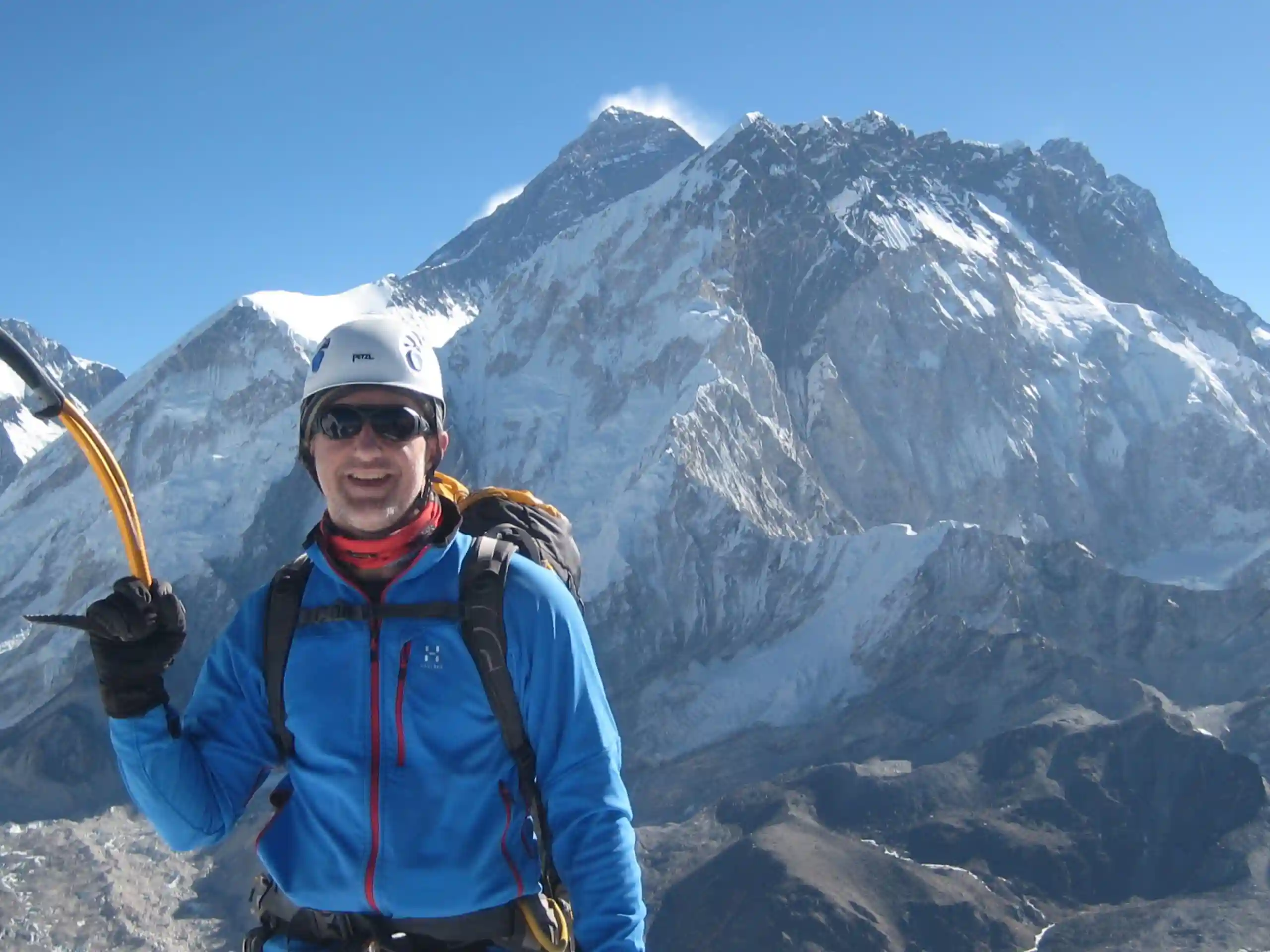
 Group Size: 1-15 PAX
Group Size: 1-15 PAX  Duration: 20 Days
Duration: 20 Days  Trip Start: Kathmandu
Trip Start: Kathmandu  Trip End: Kathmandu
Trip End: Kathmandu  Average Dist. per Day: 12KM
Average Dist. per Day: 12KM  Average Time per Day: 5Hrs
Average Time per Day: 5Hrs  Trip Grading: Challenging
Trip Grading: Challenging 